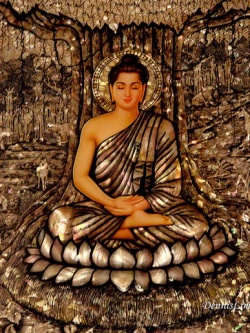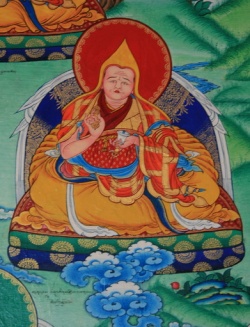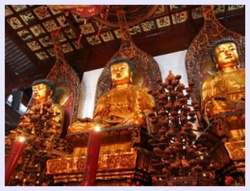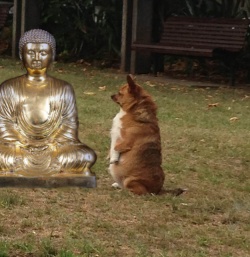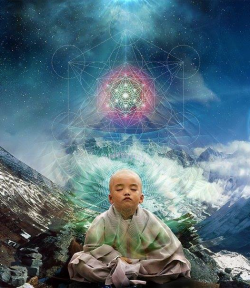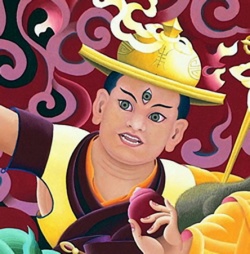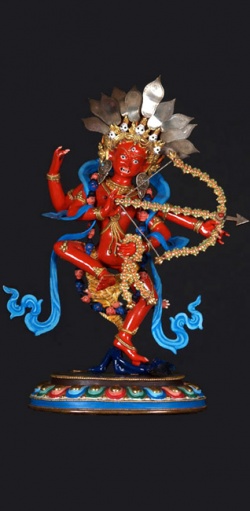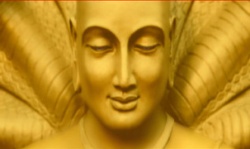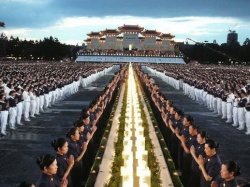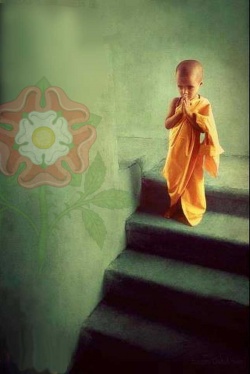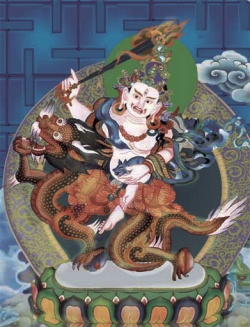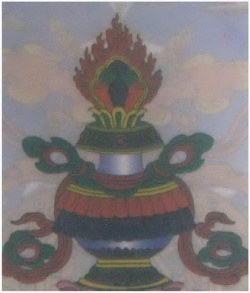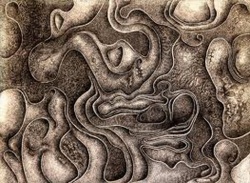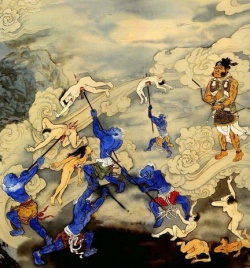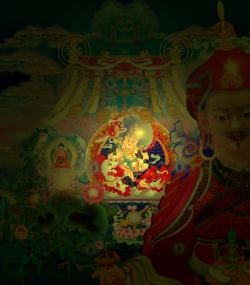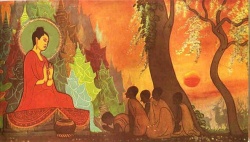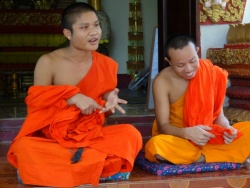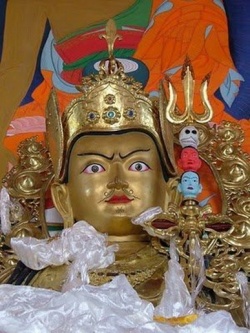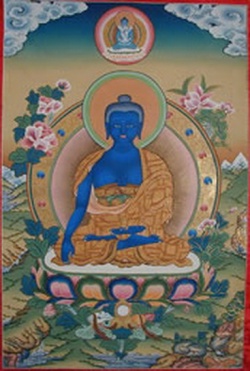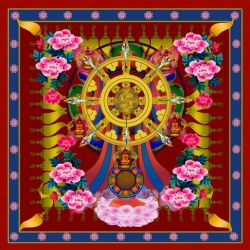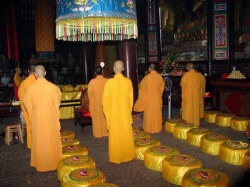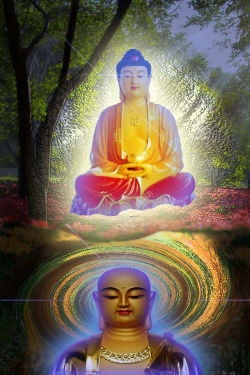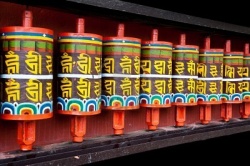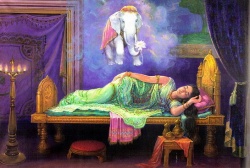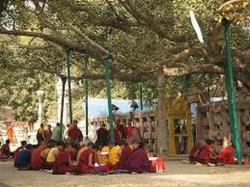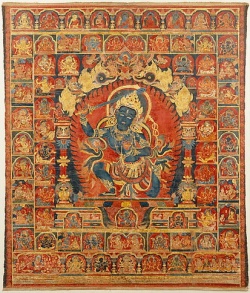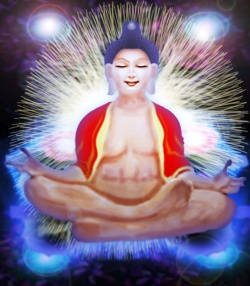Difference between revisions of "Lalitavistara."
(Created page with "<poem> The Mahāvastu describes itself as a work belonging to Hīnayāna, although it has assimilated some of the Mahāyāna {{Wiki|features}}. The [[Lalitavistar...") |
m (Text replacement - "]]]" to "]])") |
||
| (29 intermediate revisions by 5 users not shown) | |||
| Line 1: | Line 1: | ||
| − | + | [[File:10d2fd63.jpg|thumb|250px|]]<nomobile>{{DisplayImages|693|692|2563|3945|1035|744|2533|635|3483|50|3650|1074|2623|495|2518|3905|1066|4183|3558|3341|610|4561|67|3910|1695|841|2421|4210|1298|2194}}</nomobile> | |
| − | |||
| − | |||
| − | |||
| − | |||
| − | |||
| − | |||
| − | + | {{Seealso|Lalitavistara}} | |
| − | + | <poem> | |
| − | + | The [[Mahāvastu]] describes itself as a work belonging to [[Hīnayāna]], although it has assimilated some of the [[Mahāyāna]] {{Wiki|features}}. The [[Lalitavistara]] on the contrary is regarded as one of the most [[sacred]] [[Mahāyāna]] texts, as a [[Vaipulya]] [[Sūtra]]. It is a text-book of voluminous contents and gives the usual designation of a [[Mahāyāna Sūtra]] and yet originally the work [[embodied]] a descriptive [[life of the Buddha]] for the Sārvāṣṭivādi school [[attached]] to the [[Hīnayāna]]. | |
| − | The [[ | + | The [[Lalitavistara]] is edited by [[S. Lefmann]] who also brought out a translation of the first chapters in {{Wiki|Berlin}} in 1875. The great {{Wiki|Bengali}} [[scholar]] [[Rajendralal Mitra]] prepared an English translation for the [[Bibliotheca Indica]] of which 3 fasciculi have appeared. ([[Calcutta]], 1881 to 1886). He has also brought out an incomplete text. A complete {{Wiki|French}} translation by Foucaux appeared in {{Wiki|Paris}} in the Annals du Musee Guimet, vol. vi, xix, ({{Wiki|Paris}}, 1887-1892.) The {{Wiki|Chinese}} [[tradition]] as to the [[Lalitavistara]] makes it a [[life of the Buddha]] representing the Sārvāṣṭivādi school (Beal, the Romantic Legend of [[Śākya]] [[Buddha]] from the {{Wiki|Chinese}} [[Sanskrit]], {{Wiki|London}}, 1875, Introduction. Also [[Foucaux's]] {{Wiki|French}} translation of [[Lalitavistara]] introduction, vol. 11.) Beal's Romantic Legend is an abbridged translation from the {{Wiki|Chinese}} version of the [[Abhiniṣkramaṇa Sūtra]] which has not been preserved in the original [[Sanskrit]], but was translated into {{Wiki|Chinese}} so early as 587 A.D. It appears to have been a {{Wiki|biography}} of the [[Buddha]] representing the [[sect]] of the [[Dharmaguptas]]. |
| − | + | The [[Mahāyāna]] [[idea]] however corresponds already to the very title of the [[Lalitavistara]] which means the “exhaustive {{Wiki|narrative}} of the sport of the [[Buddha]].” [[Thus]] the lifework of the [[Buddha]] on the [[earth]] is characterised as the diversion ([[lalita]]) of a [[supernatural]] {{Wiki|being}}. | |
| + | [[File:04351.jpg|thumb|250px|]] | ||
| + | In the introductory [[chapter]] the [[Buddha]] appears as an [[exalted]] [[divine]] [[being]], although the [[chapter]] starts after the mode of the [[ancient]] [[Pāḷi]] [[Suttas]] with the words: “So have I [[heard]]. Once upon a [[time]] the [[Master]] was sojourning at [[Śrāvastī]] in the [[Jeta Park]] in the [[garden]] of [[Anāthapiṇḍada]].” [20] | ||
| − | + | Extravagant [[Imagery]] | |
| − | + | But while in the [[Pāḷi]] texts the [[Master]] is introduced with these or similar stereotyped initial phrases and is surrounded by a few [[disciples]] or at the most his suite of “500 [[monks]],” and then immediately the [[Sutta]] proper begins, in the [[Lalitavistara]], as in all the [[Vaipulya Sūtras]] of the [[Mahāyāna]], the picture that is outlined of the [[Buddha]] is a grandiose one encircled by [[divine]] radiance. He is surrounded by twelve thousand [[monks]] and by no less than thirty-two thousand [[Bodhisattvas]], “all still in the trammels of only one [[re-birth]], all born with the [[perfections]] of a [[Bodhisattva]], all enjoying the [[knowledge]] of a [[Bodhisattva]], all in the possession of an [[insight]] in [[magical]] charms” and so forth. | |
| − | + | While in the middle watch of the night the [[Buddha]] sits sunk in [[meditation]], from his {{Wiki|head}} issues forth a {{Wiki|stream}} of [[light]] which penetrates into the [[heavens]] and sets all the [[gods]] in commotion. These [[latter]] forthwith [[chant]] a hymn of praise to the [[exalted]] [[Buddha]] and soon after appear {{Wiki|Iśvara}} and the other [[divinities]] before the [[Master]], [who] throw themselves at his feet and implore him to reveal the {{Wiki|excellent}} [[Vaipulya Sūtra]] called the [[Lalitavistara]] for the {{Wiki|salvation}} and [[blessing]] of the [[world]]. While they {{Wiki|panegyric}} in extravagant terms the excellences of the text revealed by this and even earlier [[Buddhas]], the [[Buddha]] expresses his assent by [[silence]]. Only after these circumstantial introductions, which fill a large [[chapter]] commences the {{Wiki|biography}} proper of the [[Buddha]] which [[forms]] the contents of the work. And it starts indeed just from where in the [[Pāḷi]] [[Nidānakathā]] the second section ([[avidūrenidāna]]) begins. | |
| + | [[File:0147.jpg|thumb|250px|]] | ||
| + | {{Wiki|Conception}} and [[Birth]] of [[Buddha]] | ||
| − | + | The [[Bodhisattva]] abides in the [[heaven]] of the Gratified ([[Tuṣita]]) [[gods]] in a glorious [[celestial]] palace. The [[Bodhisattva]] is the recipient of over a hundred honorific {{Wiki|epithets}} and the [[celestial]] palace in which he resides of over a dozen. Under the [[sound]] of eighty-four thousand [[drums]] he is called upon to descend to the [21] [[earth]] to commence his work of {{Wiki|salvation}}. After long consultations in which the excellences and the deficiencies of a large number of princely families are weighed the [[Bodhisattva]] finally decides to be [[re-born]] in the house of [[King]] [[Śuddhodana]] in the [[womb]] of [[Queen Māyā]]. She alone possesses all the qualities of a [[Buddha's]] mother. Perfect like her [[beauty]], which is described to minutest detail, are her [[virtue]] and [[chastity]]. Besides, of all the women of [[India]] she is the only one in a position to bear the [[future Buddha]] since in her is united the strength of ten thousand [[elephants]]. The {{Wiki|conception}} proceeds with the assistance of the [[gods]] after the [[Bodhisattva]] had determined to enter the [[womb]] of his mother in the [[form]] of an [[elephant]]. The [[gods]] prepare not only a [[celestial]] residence for [[Māyā]] during her {{Wiki|lying}} in, but construct a palace of [[jewels]] in her [[womb]] so that the [[Bodhisattva]] may not remain soiled there for ten months. In this palace of [[jewels]] he sits in his marvellous tenderness. But his [[body]] shines in glorious sheen and a [[light]] expands itself for {{Wiki|miles}} from the [[womb]] of his mother. The sick come to [[Māyā Devī]] and are cured of their {{Wiki|diseases}} as soon as the [[latter]] places her hand upon their {{Wiki|head}}. And whenever she looks towards her right she sees the [[Bodhisattva]] in her [[womb]] “just as a man beholds his [[own]] face in a clear [[mirror]].” The yet {{Wiki|unborn}} [[Bodhisattva]] in his mother's [[womb]] delights the [[celestials]] by pious [[sermons]] and the [[god]] [[Brahmā]] obeys his every suggestion. | |
| − | + | This part is comprised in chapters 2 to 6. The beginning of the sixth [[chapter]] has been translated by Windisch in his [[Buddha's]] Geburt, p. 162 ff. | |
| + | [[File:Achala3774.jpg|thumb|250px|]] | ||
| + | As the {{Wiki|conception}} so also the [[Bodhisattva's]] [[birth]]. It is accompanied by [[miracles]] and portents. In the [[Lumbini]] Park he is born in the [[manner]] well known to us through numerous sculptures though not like an ordinary [[human]] but as an [[omniscient]] [[Exalted]] [[Being]], as a [[Mahāpuruṣa]], “The Great [[Spirit]].” [[Lotus]] [[flowers]] are strewn under every [22] step of his and the newborn child announcing his greatness takes seven steps towards each of the six [[cardinal points]]. | ||
| − | + | The [[creator]] [[Prajāpati]] is characterized as [[Puruṣa]] and [[Mahāpuruṣa]] in the {{Wiki|Brāhmaṇas}} and {{Wiki|Upaniṣads}} and subsequently also [[Brahmā]] and {{Wiki|Viṣṇu}}. The seven steps of the new born child [[Buddha]] are also to be explained from the [[myth]] of the march of {{Wiki|Viṣṇu}}. | |
| − | + | [[Sin]] of Unbelief | |
| − | + | Here the {{Wiki|narrative}} [is] interrupted by a {{Wiki|dialogue}} between [[Ānanda]] and the [[Buddha]] in which vehemence is shown towards every unbeliever who does not credit the miraculous [[birth]] of the [[Buddha]] ([[chapter]] vii, p. 87 to 91). [[Faith]] in the [[Buddha]] is [[taught]] as an [[essential]] component of [[religion]]. And we are reminded of [[Krṣṇa]] in the {{Wiki|Bhagavadgīta}} when the [[Buddha]] says: | |
| − | + | “To all who believe in me I do good. Like friends are they to me who seek [[refuge]] in me. And many a [[friend]] the [[Tathāgata]] has. And to those friends the [[Tathāgata]] only speaks the [[truth]], not falsehood.... To believe [[Ānanda]] should be thy endeavour. This I commend unto you.” | |
| + | [[File:111.jpg|thumb|250px|]] | ||
| + | Why this {{Wiki|dialogue}} should appear just here is certainly not due to accident, but is based on the fact that it is with reference to the {{Wiki|legends}} relating to the {{Wiki|conception}} and the [[birth]] of the [[Buddha]] that the [[Lalitavistara]] diverges very strikingly from other [[Buddhist]] schools in its extravagance as to the miraculous. It is no longer so in the {{Wiki|future}} course of the {{Wiki|narrative}}. Indeed there is here very often an [[extraordinary]] [[harmony]] with the most [[ancient]] [[Pāḷi]] account, e.g., that of the [[Mahāvagga]] of the [[Vinaya piṭaka]], although it may be noted incidentally that the [[Gāthās]] of the [[Lalitavistara]] appear more [[ancient]] than those in the [[corresponding]] [[Pāḷi]] texts. | ||
| − | The [[Buddha]] | + | The [[relation]] of the [[Pāḷi]] [[tradition]] to the [[Lalitavistara]] is treated of by [[Wikipedia:Hermann Oldenberg|Oldenberg]] in Orientalistenkongresse, V 1882, vol. 2, [23] p. 1017 to 1022 and Windisch in [[Māra]] and [[Buddha]] and [[Buddha's]] [[Birth]] as well as by Kern in [[Sacred]] [[Books]] of the {{Wiki|East}}, vol. 21, p. xi ff and last but not least by [[Burnouf]] [[Lotus]] de la Bonne Loi, p. 864 f. |
| − | + | [[Pāḷi]] and [[Sanskrit]] go back to an Older Source | |
| − | + | The two texts in such cases are not [[dependent upon]] each other, but both go back to a common older [[tradition]]. But even here the [[Lalitavistara]] has much that is wanting in the older accounts. Two episodes in particular are noteworthy. One of these recounts ([[chapter]] 8) how the [[Bodhisattva]] as a boy is brought by his foster mother to the [[temple]] and how all the images of the [[gods]] rise up on their pedestals to [[prostrate]] themselves at his feet. The other episode ([[chapter]] 10) relates the first [[experience]] of the [[Bodhisattva]] at school. | |
| − | + | The [[Buddha]] at School | |
| − | + | With a suite of ten thousand boys with immense pomp in which the [[gods]] participate - eight thousand [[heavenly]] damsels for instance scatter [[flowers]] before him - the small [[Bodhisattva]] celebrates his admission into the [[writing]] school. The poor schoolmaster cannot bear the glory of the [[divine]] [[incarnation]] and falls to the ground. A [[god]] raises him up and [[tranquillizes]] him with the explanation that the [[Bodhisattvas]] are [[omniscient]] and need no {{Wiki|learning}}, but that they come to school only following the course of the [[world]]. Then the [[Bodhisattva]] amazes the schoolmaster with the question as to which of the 64 scripts he was going to instruct him in. And he enumerates all the sixty-four in which are included the {{Wiki|Chinese}} [[symbols]] and the [[script]] of the {{Wiki|Huns}} - alphabets of which the [[teacher]] did not [[know]] even the names. Finally with the ten thousand boys he commences his study of the [[alphabet]]. With every [[letter]] of the [[alphabet]] the [[Bodhisattva]] pronounces a [[wise]] maxim. [24] | |
| − | + | According to E. [[Kuhn]], Gurupūjā [[Kaumudi]] (p. 116 f.) these two {{Wiki|legends}} of the child [[Buddha]] may have served as models for the Gospels [[Apocrypha]] which relate similar stories of the child {{Wiki|Jesus}}. The [[chapter]] 12 and 13 also contain episodes which are wanting in the other {{Wiki|biographies}} of the [[Buddha]] (Winternitz WZKM 1912, p. 237 f.) | |
| − | + | Acts of the [[Buddha]] | |
| − | + | On the other hand in its further course the [[Lalitavistara]] {{Wiki|narrative}} (chapters 14-26) deviates only a little from the legend known to us from other sources; the [[principal]] events in the [[life of the Buddha]] [[being]] the [[four meetings]] from which the [[Bodhisattva]] learns of [[old age]], {{Wiki|disease}}, [[death]] and [[renunciation]]; the flight from the palace; the encounter with [[King]] [[Bimbisāra]]; [[Gautama]]'s years of instruction and his futile [[ascetic]] practices; the struggle with [[Māra]]; the final [[illumination]] and the enunciation of the [[doctrine]] to the [[world]] at large at the request of [[god]] [[Brahmā]]. But even here the [[Lalitavistara]] is remarkable for its exaggerations. While [[Gautama]], for instance, passes the four weeks after his [[illumination]], in our most [[ancient]] account, in [[meditation]] under various [[trees]] ([[Mahavagga]] 1, 1-4, Dutoit [[Life]] of the [[Buddha]], p. 66), in the [[Lalitavistara]] (p. 377), in the second [[week]], he goes out for a long promenade through thousands of [[worlds]] and in the fourth [[week]] takes a small walk, which stretches only from the eastern to the [[western]] ocean. The last [[chapter]] (27) however is once again after the fashion of the [[Mahāyāna sūtras]], a glorification of the [[book]] of [[Lalitavistara]] itself, and is devoted to the {{Wiki|enumeration}} of the [[virtues]] and the advantages which a man acquires by its [[propagation]] and reverence. | |
| − | + | Component [[Elements]] of [[Lalitavistara]] | |
| − | + | From all these it is quite probable that our [[Lalitavistara]] is a redaction of an older [[Hīnayāna]] text expanded and embellished in the [[sense]] of the [[Mahāyāna]] - a {{Wiki|biography}} of the [[Buddha]] representing the Sārvāṣṭivāda school. This assumption also explains the [[nature]] of the text which is by no means the single work of [25] one author, but is an anonymous compilation in which very old and very young fragments stand in juxtaposition. The [[book]] moreover consists, according to its [[form]], of unequal [[sections]], a continuous {{Wiki|narrative}} in [[Sanskrit]] prose and numerous, often extensive, metrical pieces in “Mixed [[Sanskrit]].” Only rarely these verses constitute a portion of the {{Wiki|narrative}}. As a {{Wiki|rule}} they are recapitulations of prose narration in an abbreviated and simpler and sometimes also more or less divergent [[form]]. Many of these metrical pieces are [[beautiful]] old ballads which go back to the same [[ancient]] sources as the [[poems]] of the [[Pāḷi]] [[Sutta nipāta]] mentioned above. The examples are the [[birth]] legend and the [[Asita]] episode in [[chapter]] VII, the [[Bimbisāra]] {{Wiki|history}} in [[chapter]] XVI and the {{Wiki|dialogue}} with [[Māra]] in [[chapter]] XVIII. They, belong to the [[ancient]] [[religious]] ballad poesy of the first centuries after the [[Buddha]]. But several prose passages also, like the {{Wiki|sermon}} at [[Benares]] in the XXVIth [[chapter]], are assignable to the most [[ancient]] stratum of [[Buddhistic]] [[tradition]]. On the other hand the younger components are to be found not only in the prose but also in the [[Gāthās]], many of which are composed in highly artistic metres. Such are the [[Vasantatilaka]] and [[Śārdūlavikrīḍita]] which are tolerably frequent (see the index to metres in Lefmann's edition VII, p. 227 f, and Introduction, p. 19 ff). | |
| − | + | Translation into {{Wiki|Chinese}} and [[Tibetan]] | |
| − | + | We do not [[know]] when the final redaction of the [[Lalitavistara]] took place. It was formerly erroneously asserted that the work had already been translated into {{Wiki|Chinese}} in the first {{Wiki|Christian}} century. As a {{Wiki|matter}} of fact we do not at all [[know]] whether the {{Wiki|Chinese}} {{Wiki|biography}} of the [[Buddha]] called the [[Phuyau-king]] which was published in about 300 A.D., the alleged “second translation of the [[Lalitavistara]],” is really a translation of our text (Winternitz, WZKM 1912, p. 241 f.) A precise rendering of the [[Sanskrit]] text is in the [[Tibetan]], which was only [26] produced in the 5th century. It has been edited and translated into {{Wiki|French}} by Foucaux. It may be taken for certain that a version little different from our [[Lalitavistara]] was known to the {{Wiki|artists}} who about 850-900 decorated with images the celebrated [[temple]] of [[Borobudur]] in {{Wiki|Java}}. For these magnificent [[scriptures]] represent scenes in the legend of the [[Buddha]] in a [[manner]] as if the {{Wiki|artists}} were working with the text of the [[Lalitavistara]] in the hand. And Pleyte has simply recapitulated the entire contents of the [[Lalitavistara]] as an explanation of the sculptures (The [[Buddha]] legend in the {{Wiki|sculpture}} in the [[temple]] of [[Borobudur]], {{Wiki|Amsterdam}}, 1901. See also Speyer La Museon 1903, p. 124 ff). | |
| − | + | [[Relation]] to [[Buddhist]] [[Art]] | |
| − | + | But the {{Wiki|artists}} who embellished the Greco-Buddhistic monuments of [[Northern]] [[India]] with scenes from the [[life of the Buddha]] are also already familiar with the [[Buddha]] legend as related in the [[Lalitavistara]]. They worked no [[doubt]] not after the text, but in accordance with living [[oral tradition]]. The [[harmony]], nevertheless, between the sculptures and the [[Sanskrit]] text is not rarely of such a [[character]] that we must assume that the {{Wiki|literary}} [[tradition]] was at times influenced by the artist. Upon [[art]] and {{Wiki|literature}} there was mutual influence. | |
| − | + | The authorities to be consulted here are L'art Greco-bouddhique du [[Gandhāra]], part I, 324 f. 666 ff; [[Grunwendel]] [[Buddhist Art]] in lndia, p.94, 04 f, 134; Senart Orientalistenkongresse XIV, 1905, 1,121 ff; and Bloch Zeitschift der Deutschen Morgenlandischen Gesellschaft 62, p. 370 ff. | |
| − | + | No Image in Primitive [[Buddhism]] | |
| − | + | While the [[ancient]] [[Buddhistic]] [[art]] in the [[time]] of [[Aśoka]], in the reliefs of [[Bharhut]], [[Sanchi]], etc., [[knows]] of no image of the [[Buddha]] but only a [[symbol]] (e.g., the [[wheel]]) for the [[person]] of the Founder of the [[religion]], a [[representation]] of the [[Buddha]] is the [[principal]] [[object]] of the [[Gandhāra]] [[art]]. Can it not be connected with this that in the intervening centuries the [[Buddha]] became an [[object]] of [[Bhakti]] and the adoration of the [[Buddha]] was pushed into the central point of his [[religion]]? [[Thus]] there is [27] concurrent testimony that the age of the [[Gandhāra]] [[art]], the floruit of which falls in the second century after {{Wiki|Christ}}, was also the period of [[Mahāyāna]] texts which treat of the [[Buddha]] legend. | |
| − | + | “On the grounds of style derived in the first instance from {{Wiki|Greco-Roman}} [[art]] the period of the [[development]] can only be the period from the [[birth]] of {{Wiki|Christ}} to the fourth century.” [[Wikipedia:Albert Grünwedel|Grunwendel]] [[Buddhist Art]] in [[India]], p. 81. According to Foucher L'art Greco-bouddhique du [[Gandhāra]], part 1. p.40 ff. the flourishing period of the [[Gandhāra]] [[art]] coincides with the second half of the second century A.D. | |
| + | General Estimate of [[Lalitavistara]] | ||
| − | + | It is, therefore, but natural that we should have preserved in the [[Lalitavistara]] both the very old [[tradition]], and accounts younger by centuries, of the legend of the [[Buddha]]. An important source of old [[Buddhism]] it is only there, where it coincides with the [[Pāḷi]] texts and other [[Sanskrit]] texts like the [[Mahāvastu]]. But it is erroneous to regard the [[Lalitavistara]] in its entirety as a good old source for our [[knowledge]] of [[Buddhism]] as does Senart in his ingenious and unsuccessful Essai sur la legende du [[Buddha]], (p. 31 f., 456 f.). Nor does the [[Lalitavistara]] give us a clue “to popular [[Buddhism]]” of older times as is claimed by Vallee [[Wikipedia:Louis de La Vallée-Poussin|Poussin]]. It is rather a key to the [[development]] of the [[Buddha]] legend in its earliest beginnings, in which only the [[principal]] events of the [[life]] of the great founder of the [[religion]] have been adorned with [[miracles]], down to the final apotheosis of the [[Master]] in which from start to finish his career appears more like that of a [[god]], above all the other [[gods]]. But from the standpoint of {{Wiki|literary}} {{Wiki|history}} the [[Lalitavistara]] is one of the most important works in [[Buddhist]] {{Wiki|literature}}. It is not indeed a [[Buddha]] {{Wiki|epic}} proper, but it [[embodies]] all the germs of one. It was from the ballads and episodes which have been preserved in the oldest [[elements]] of the [[Lalitavistara]], if probably not from the [[Lalitavistara]] itself, that the greatest poet of [[Buddhism]], [[Aśvaghoṣa]], created his magnificent {{Wiki|epic}} called [[Buddhacarita]] or [[Life]] of the [[Buddha]]. [28] | |
| − | + | [[LALITAVISTARA]] | |
| − | + | [[R. Banerjee]] | |
| − | LALITVISTARA ([[Sanskrit]]) is a [[Sanskrit]] [[Buddhist text]] of great importance. Apart from [[being]] a biography of [[Buddha]], originally of the [[Sarvastivada]] School of the [[Hinayana]] sect, it throws a considerable [[light]] also on the {{Wiki|social}} and cultural {{Wiki|history}} of [[India]] during the early centuries of the {{Wiki|Christian}} era. | + | [[LALITVISTARA]] ([[Sanskrit]]) is a [[Sanskrit]] [[Buddhist text]] of great importance. Apart from [[being]] a {{Wiki|biography}} of [[Buddha]], originally of the [[Sarvastivada]] School of the [[Hinayana]] [[sect]], it throws a considerable [[light]] also on the {{Wiki|social}} and {{Wiki|cultural}} {{Wiki|history}} of [[India]] during the early centuries of the {{Wiki|Christian}} {{Wiki|era}}. |
| − | The [[name]] '[[Lalitavistara]]' means the detailed {{Wiki|narrative}} of the sports or 'lila' of [[Gautama]] the [[Buddha]], indicating his [[divinity]]. It describes the events of [[Gautama]] [[Buddha's]] [[life]] from his descent from the [[Tushita heaven]] in the [[form]] of a white elephant into his mother's [[womb]] up to his [[attainment]] of [[knowledge]] and preaching of the first sermon. | + | The [[name]] '[[Lalitavistara]]' means the detailed {{Wiki|narrative}} of the [[sports]] or '[[lila]]' of [[Gautama]] the [[Buddha]], indicating his [[divinity]]. It describes the events of [[Gautama]] [[Buddha's]] [[life]] from his descent from the [[Tushita heaven]] in the [[form]] of a [[white elephant]] into his mother's [[womb]] up to his [[attainment]] of [[knowledge]] and preaching of the [[first sermon]]. |
| − | The [[Lalitavistara]] is not a unified text nor it is a composition of one author. And it is not known when it was redacted in the final [[form]] as we [[know]] it now. It is a compilation of old and later [[traditions]] placed side by side. In other words, it was originally a [[Sarvastivada]] text, which was later on expanded and embellished with [[Mahayana]] ideas laying emphasis on [[Buddha's]] superhuman [[character]] and miraculous [[deeds]]. According to P. L. Vaidya, the present [[Sanskrit]] text goes back to the 3rd century A.D. By the late fifth century when the poet Wang {{Wiki|Jung}} (468-93( wrote his cycle of twelve songs "Songs of [[Religious]] [[Joy]]", there were at least five versions of the [[Lalitavistara]] in [[China]]. The [[Lalitavistara]] [[forms]] a part of Nanadharma | + | The [[Lalitavistara]] is not a unified text nor it is a composition of one author. And it is not known when it was redacted in the final [[form]] as we [[know]] it now. It is a compilation of old and later [[traditions]] placed side by side. In other words, it was originally a [[Sarvastivada]] text, which was later on expanded and embellished with [[Mahayana]] [[ideas]] laying {{Wiki|emphasis}} on [[Buddha's]] superhuman [[character]] and miraculous [[deeds]]. According to P. L. [[Vaidya]], the {{Wiki|present}} [[Sanskrit]] text goes back to the 3rd century A.D. By the late fifth century when the poet Wang {{Wiki|Jung}} (468-93( wrote his cycle of twelve songs "Songs of [[Religious]] [[Joy]]", there were at least five versions of the [[Lalitavistara]] in [[China]]. The [[Lalitavistara]] [[forms]] a part of [[Nanadharma]] 0of {{Wiki|Nepalese}} [[Mahayana Buddhism]] and also of the [[Tibetan canon]] and it was translated into that [[language]] in the 9th century A.D. It may be mentioned here that the [[Tibetan]] translation of the [[Lalitavistara]] is considered to be very [[Wikipedia:Authenticity|authentic]] and close to the [[Sanskrit]] text. |
| − | The [[Lalitavistara]] has been translated also into many European languages and it is [[interesting]] to note that Edward Arnold's '[[Light | + | The [[Lalitavistara]] has been translated also into many {{Wiki|European}} [[languages]] and it is [[interesting]] to note that [[Wikipedia: Edwin Arnold|Edward Arnold]]'s '[[Wikipedia:The Light of Asia|Light of Asia]] is based mainly upon the [[Lalitavistara]]. It may, however, be noted that a version slightly differing from the [[Lalitavistara]] was also in vogue, which was followed by the {{Wiki|artists}} of [[Barabudur]] from about 850 to 900 A.D. It can also be assumed that the {{Wiki|artists}} of [[Gandhara]] who embellished the [[Buddhist]] monuments with the scenes from [[Buddha's]] [[life]] were acquainted with the text of the [[Lalitavistara]]. |
| − | The [[Lalitavistara]] in its expanded [[form]] came to be known as a [[Vaipulya]] [[sutra]]. The other [[Mahayana]] a texts known as a [[Vaipulya]] suytras are: The | + | The [[Lalitavistara]] in its expanded [[form]] came to be known as a [[Vaipulya]] [[sutra]]. The other [[Mahayana]] a texts known as a [[Vaipulya]] suytras are: The [[Ashtasahasrika Prajnaparamita]] the [[Saddharma pundarika]], the [[Lankavatara]], the [[Suvarnaprabhasa]], the [[Gandavyuha]], the [[Tathagataguhyaka]] or [[Tathagata-guna-jnana]], the [[Samadhiraja]] and the [[Dasabhumishvara]], Though the [[Lalitavistara]] belonged to the transition between the [[Hinayana]] and the [[Mahayana]]. It has been established that many of the verses and prose passages in the [[Lalitavistara]] have come from the [[Sarvastivada]] [[canon]], while its [[Mahayana]] leanings and [[elements]] are apparent from such terms as [[Dharmatathata]], [[Bhutakoti]], etc. as well as [[Buddha's]] statement that he has [[attained]] the [[void]] of the [[world]] ([[Jagachhunya]]). |
| − | In the [[Lalitavistara]], the miraculous acts of the [[Buddha]] as noted above have been emphasised. Just before his last [[birth]], he ([[Buddha]]) lived in the [[Tushita heaven]]. He was greeted with the {{Wiki|sounds}} of eighty-four thousand drums and requested to come down to the [[earth]] for the release of the [[people]] from the bondage of [[birth]] and [[death]]. The [[Bodhisattva]] chose to be born in the [[Shakya]] family of [[kapilavastu]] with [[Shuddhodana]] as his father and {{Wiki|queen}} [[Maya]] as his mother. He did not stay in the filth of his mothers [[womb]] as other children do. [[Gods]] provided a jewelled box for him to stay in his mother's [[womb]]. From his [[body]] amanated [[light]] shining far and wide. 'The yet unborn [[Bodhisattva]] in his mother's [[womb]] [[delight]] the [[celestials]] by pious sermons and the [[god]] [[Brahma]] obeyed his every suggestion.' The [[Buddha's]] [[birth]] also was attended by various [[miracles]] and portents. He was born in [[Lumbini]] as a '[[great being]]' and just after his [[birth]] he took seven steps (comparable to Vishnu's three steps as Trivikrama) announcing his greatness that this was his last [[birth]] after which he would not be subjected to the chain of [[birth]] and death. | + | In the [[Lalitavistara]], the miraculous acts of the [[Buddha]] as noted above have been emphasised. Just before his last [[birth]], he ([[Buddha]]) lived in the [[Tushita heaven]]. He was greeted with the {{Wiki|sounds}} of eighty-four thousand [[drums]] and requested to come down to the [[earth]] for the [[release]] of the [[people]] from the bondage of [[birth]] and [[death]]. The [[Bodhisattva]] chose to be born in the [[Shakya]] [[family]] of [[kapilavastu]] with [[Shuddhodana]] as his father and {{Wiki|queen}} [[Maya]] as his mother. He did not stay in the filth of his mothers [[womb]] as other children do. [[Gods]] provided a jewelled box for him to stay in his mother's [[womb]]. From his [[body]] amanated [[light]] shining far and wide. 'The yet {{Wiki|unborn}} [[Bodhisattva]] in his mother's [[womb]] [[delight]] the [[celestials]] by pious [[sermons]] and the [[god]] [[Brahma]] obeyed his every suggestion.' The [[Buddha's]] [[birth]] also was attended by various [[miracles]] and portents. He was born in [[Lumbini]] as a '[[great being]]' and just after his [[birth]] he took seven steps (comparable to {{Wiki|Vishnu}}'s three steps as [[Trivikrama]]) announcing his greatness that this was his last [[birth]] after which he would not be subjected to the chain of [[birth]] and [[death]]. |
| − | The above description was followed by a dialogue between the [[Buddha]] and [[Ananda]] in which every one is urged to believe in the miraculous [[birth]] of the [[Buddha]]. Here the importance of [[religious]] [[faith]] is emphasised, echoing almost similar sentiments in the Bhagavadgita. The [[Buddha]] says: "To all who believe in me I do good Like friends are they to me and many a friend the [[Tathagata]] has. And to those friends, the [[Tathagata]] only speaks the [[truth]] and not falsehood... To believe [[Ananda]] should be thy endeavour. This I commend to you. "[[Thus]], the [[Lalitavistara]] lays [[stress]] on the devotional aspects of [[Mahayana]] | + | The above description was followed by a {{Wiki|dialogue}} between the [[Buddha]] and [[Ananda]] in which every one is urged to believe in the miraculous [[birth]] of the [[Buddha]]. Here the importance of [[religious]] [[faith]] is emphasised, echoing almost similar sentiments in the {{Wiki|Bhagavadgita}}. The [[Buddha]] says: "To all who believe in me I do good Like friends are they to me and many a [[friend]] the [[Tathagata]] has. And to those friends, the [[Tathagata]] only speaks the [[truth]] and not falsehood... To believe [[Ananda]] should be thy endeavour. This I commend to you. "[[Thus]], the [[Lalitavistara]] lays [[stress]] on the devotional aspects of [[Mahayana]] [[Buddhim]]. |
| − | Again, the [[Lalitavistara]] tells us that when the newly born [[Bodhisattva]] was taken by his foster mother to a [[temple]], all the [[gods]] rose from their seats and prostrated before him. He showed [[extraordinary]] [[merit]] also as a learner. [[Heavenly]] damsels scattered [[flowers]] on the [[path]] the child [[Bodhisattva]] followed in coming to his school. The school [[master]], unable to bear his radiance, fell down and fainted on the ground. A [[god]] roused him. [[Bodhisattva]] needed no instructions as he was [[omniscient]]. But he came to school as a matter of [[worldly]] routine. It is said in the [[Lalitavistara]] that the [[Buddha]] came to this [[world]] as Lokanuvartana (i.e. to follow the ways of the [[world]]). The [[teacher]] amazed to find that [[Bodhisattva]] knew all the sixty-four alphabets including the {{Wiki|Chinese}} and Huna [[symbols]]. The remaining narratives of the [[Lalitavistara]], chapters 14-26, though containing many exaggerations show close similarity with the other sources. The last chapter, in the [[Mahayana]] fashion glorifies the text and refers to the [[merits]] or advantage one derives from its propagation. | + | Again, the [[Lalitavistara]] tells us that when the newly born [[Bodhisattva]] was taken by his foster mother to a [[temple]], all the [[gods]] rose from their seats and prostrated before him. He showed [[extraordinary]] [[merit]] also as a learner. [[Heavenly]] damsels scattered [[flowers]] on the [[path]] the child [[Bodhisattva]] followed in coming to his school. The school [[master]], unable to bear his radiance, fell down and fainted on the ground. A [[god]] roused him. [[Bodhisattva]] needed no instructions as he was [[omniscient]]. But he came to school as a {{Wiki|matter}} of [[worldly]] routine. It is said in the [[Lalitavistara]] that the [[Buddha]] came to this [[world]] as [[Lokanuvartana]] (i.e. to follow the ways of the [[world]]). The [[teacher]] amazed to find that [[Bodhisattva]] knew all the sixty-four alphabets [[including]] the {{Wiki|Chinese}} and [[Huna]] [[symbols]]. The remaining [[Wikipedia:narrative|narratives]] of the [[Lalitavistara]], chapters 14-26, though containing many exaggerations show close similarity with the other sources. The last [[chapter]], in the [[Mahayana]] fashion glorifies the text and refers to the [[merits]] or advantage one derives from its [[propagation]]. |
| − | The [[Lalitavistara]] is written in both prose and verses. Many of the matrical ballads are [[beautiful]] and old. They and some of the prose passages are ascribable to the first centuries after the Buddha. | + | The [[Lalitavistara]] is written in both prose and verses. Many of the matrical ballads are [[beautiful]] and old. They and some of the prose passages are ascribable to the first centuries after the [[Buddha]]. |
| − | In the last chapter of the text he is described as a Dharmakayajna (i.e. one whose [[body]] is composed of dhrama), a remarkably [[Mahayana]] idea. | + | In the last [[chapter]] of the text he is described as a [[Dharmakayajna]] (i.e. one whose [[body]] is composed of dhrama), a remarkably [[Mahayana]] [[idea]]. |
| − | The [[Lalitavistara]], apart from its importance for the [[religious]] {{Wiki|history}} of [[Buddhism]], throws some welcome [[light]] on the {{Wiki|social}} [[conditions]] of [[India]] during the early centuries of the {{Wiki|Christian}} {{Wiki|era}}. It has already been stated that it contains the names of various alphabets. Further, it mentions various arts numbering eighty-six whereas the lists in other texts speak [[traditionally]] of sixty-four arts. It also refers to various [[subjects]] of [[science]] and humanities in which a [[person]] should acquire proficiency. These [[subjects]] are ganana (arithmetic), {{Wiki|samkhya}} (use of numbers), the [[Veda]], Itihasa, [[ | + | The [[Lalitavistara]], apart from its importance for the [[religious]] {{Wiki|history}} of [[Buddhism]], throws some welcome [[light]] on the {{Wiki|social}} [[conditions]] of [[India]] during the early centuries of the {{Wiki|Christian}} {{Wiki|era}}. It has already been stated that it contains the names of various alphabets. Further, it mentions various [[arts]] numbering eighty-six whereas the lists in other texts speak [[traditionally]] of sixty-four [[arts]]. It also refers to various [[subjects]] of [[science]] and humanities in which a [[person]] should acquire proficiency. These [[subjects]] are [[ganana]] ({{Wiki|arithmetic}}), {{Wiki|samkhya}} (use of numbers), the [[Veda]], [[Itihasa]], {{Wiki|Purana}}, [[Nighantu]] ({{Wiki|lexicon}}), [[Nirukta]] ({{Wiki|etymology}}), [[Nigama]] (revealed [[scriptures]]), [[Shiksha]] ({{Wiki|phonetics}}), [[Chhandas]] (metrics), [[Jyotisha]] ({{Wiki|astronomy}}), [[Vyakarana]] ({{Wiki|grammar}}), [[Yajnakalpa]] ({{Wiki|rules}} for conducting [[sacrifices]]), [[Yoga]], and [[Vesika]] ([[philosophical]] systems), [[Barhaspatya]] ([[philosophy]] of [[Brihaspati]]), [[Hetuvidya]] ([[Nyaya]] [[philosophy]]), [[Arthavidya]] ({{Wiki|Economics}}), [[Kavyagrantharachitam]] (the [[art]] of [[writing]]), [[Akhyayana]] (the [[art]] of telling stories), [[Hasya]] (the [[art]] of humorist), etc. |
| − | A number of [[Buddhist]] legends appear in the Apocryphal Gospels. In the {{Wiki|Gospel}} of Thomas, longer version, it is mentioned: "[[Trees]] bend down before the young Christ and [[dragons]] ([[nagas]]) adore him; when he goes to school to learn the [[alphabet]] he convicts his [[teacher]] of [[ignorance]], and the good man faints.' Again, the Arabic and Syriac Gospels of the infancy glorify the Child Christ... "When he enters a [[temple]] in Egypt, the images prostrated themselves before him". These and several other exploits recorded in the case of the young Christ seem to be based on some childhood exploits of the [[Buddha]] as mentioned in the [[Lalitavistara]] as above. | + | A number of [[Buddhist]] {{Wiki|legends}} appear in the {{Wiki|Apocryphal}} Gospels. In the {{Wiki|Gospel}} of Thomas, longer version, it is mentioned: "[[Trees]] bend down before the young {{Wiki|Christ}} and [[dragons]] ([[nagas]]) adore him; when he goes to school to learn the [[alphabet]] he convicts his [[teacher]] of [[ignorance]], and the good man faints.' Again, the {{Wiki|Arabic}} and Syriac Gospels of the infancy glorify the Child {{Wiki|Christ}}... "When he enters a [[temple]] in {{Wiki|Egypt}}, the images prostrated themselves before him". These and several other exploits recorded in the case of the young {{Wiki|Christ}} seem to be based on some childhood exploits of the [[Buddha]] as mentioned in the [[Lalitavistara]] as above. |
| − | Bibliography: | + | [[Bibliography]]: |
E. J. Thomas, '[[Lalitavistara]] and [[Sarvastivada]]', [[Indian]] Historical Quarterly, Vol. XVI (1940); | E. J. Thomas, '[[Lalitavistara]] and [[Sarvastivada]]', [[Indian]] Historical Quarterly, Vol. XVI (1940); | ||
| − | G. K. Nariman, Literary History of [[Sanskrit]] [[Buddhism]] ({{Wiki|Bombay}}, 1922); | + | G. K. Nariman, {{Wiki|Literary}} History of [[Sanskrit]] [[Buddhism]] ({{Wiki|Bombay}}, 1922); |
| − | Maurice Winternitz, History of [[Indian]] Literature (Vol. II, translated into English by Mrs. S. Ketkar and Miss H. Kohn (2nd Edition, delhi, 1972); | + | Maurice Winternitz, History of [[Indian]] {{Wiki|Literature}} (Vol. II, translated into English by Mrs. S. Ketkar and Miss H. Kohn (2nd Edition, delhi, 1972); |
Nalinaksh Dutta, [[Mahayana Buddhism]] ([[Varanasi]]); | Nalinaksh Dutta, [[Mahayana Buddhism]] ([[Varanasi]]); | ||
| − | P. L. Vaidya (ed), [[Lalitavistara]] ([[Mithila]] Institute, Darbhanga) | + | P. L. [[Vaidya]] (ed), [[Lalitavistara]] ([[Mithila]] Institute, [[Darbhanga]]) |
| − | R. Kumari Mookerji, Ancient [[Indian]] Education (Motilal Banarsidass, 1951); | + | R. [[Kumari]] Mookerji, [[Ancient]] [[Indian]] [[Education]] ({{Wiki|Motilal Banarsidass}}, 1951); |
| − | Journal of the American {{Wiki|Oriental}} {{Wiki|Society}} (Vol. 107, 1987); | + | Journal of the [[American]] {{Wiki|Oriental}} {{Wiki|Society}} (Vol. 107, 1987); |
Sir Charles Eilot, [[Hinduism]] and [[Buddhism]]. Vol. III ({{Wiki|London}} 1962). | Sir Charles Eilot, [[Hinduism]] and [[Buddhism]]. Vol. III ({{Wiki|London}} 1962). | ||
| Line 127: | Line 130: | ||
Story of how the young [[Buddha]] passes his maths test | Story of how the young [[Buddha]] passes his maths test | ||
| − | King [[Suddhodana]] then asked the [[Bodhisattva]]: “Can you, my son, rival the skill of the great mathematician {{Wiki|Arjuna}} in the [[knowledge]] of mathematics?” | + | [[King]] [[Suddhodana]] then asked the [[Bodhisattva]]: “Can you, my son, rival the skill of the great {{Wiki|mathematician}} {{Wiki|Arjuna}} in the [[knowledge]] of [[mathematics]]?” |
“Sire, I can,” he replied. So the [[Bodhisattva]] was told to show his ability. | “Sire, I can,” he replied. So the [[Bodhisattva]] was told to show his ability. | ||
§1. The [[Bodhisattva]] [[knows]] up to ten numerations | §1. The [[Bodhisattva]] [[knows]] up to ten numerations | ||
| − | The great mathematician {{Wiki|Arjuna}} asked the [[Bodhisattva]]: “Young man, do you [[know]] the procedure of numeration called kotisatottara, more than a hundred kotis?” | + | The great {{Wiki|mathematician}} {{Wiki|Arjuna}} asked the [[Bodhisattva]]: “Young man, do you [[know]] the procedure of numeration called [[kotisatottara]], more than a hundred [[kotis]]?” |
The [[Bodhisattva]] answered: “I do.” [usually a [[koti]] is ten million or 10^7] | The [[Bodhisattva]] answered: “I do.” [usually a [[koti]] is ten million or 10^7] | ||
| − | “Well then, how must one proceed to enumerate more than a hundred kotis?” | + | “Well then, how must one proceed to enumerate more than a hundred [[kotis]]?” |
| + | |||
| + | The [[Bodhisattva]] replied: “A hundred [[kotis]] is called [[ayuta]]; | ||
| + | |||
| + | a hundred [[ayutas]] is called [[niyuta]]; | ||
| + | |||
| + | a hundred [[niyutas]] called [[kankara]]; | ||
| + | |||
| + | a hundred [[kankaras]] is called [[vivara]]; | ||
| + | |||
| + | and a hundred [[vivaras]] is called [[aksobhya]]; | ||
| + | |||
| + | a hundred [[aksobhyas]] is called [[vivaha]]; | ||
| + | |||
| + | a hundred [[vivahas]] is called [[utsanga]]; | ||
| + | |||
| + | a hundred [[utsangas]] is called [[bahula]]; | ||
| + | |||
| + | a hundred [[bahulas]] is called [[nagabala]]; | ||
| + | |||
| + | a hundred [[nagabalas]] is called [[titila]]; | ||
| + | |||
| + | a hundred [[titilas]] is called [[vyavasthanaprajnapti]]; | ||
| + | |||
| + | a hundred [[vyavasthanaprajnaptis]] is called [[hetuhila]]; | ||
| + | |||
| + | and a hundred [[hetuhilas]] is called [[karahu]]; | ||
| + | |||
| + | a hundred [[karahus]] is called [[hetvindriya]]; | ||
| + | |||
| + | a hundred [[hetvindriyas]] is a [[samaptalambha]]; | ||
| + | |||
| + | a hundred [[samaptalambhas]] is known as [[gananagati]]; | ||
| + | |||
| + | a hundred [[gananagatis]] is called [[niravaravadya]]; | ||
| + | |||
| + | a hundred [[niravaravadyas]] is called [[mudrabala]]; | ||
| + | |||
| + | a hundred [[mudrabalas]] is called [[sarvabala]]; | ||
| + | |||
| + | and a hundred [[sarvabalas]] is called [[visamjnagati]]; | ||
| + | |||
| + | a hundred [[visamjnagatis]] is a sarvasamjna; | ||
| + | |||
| + | a hundred [[sarvasamjnas]] is a [[vibhutangama]]; | ||
| + | |||
| + | and a hundred [[vibhutangamas]] is called [[tallaksana]]. then 100^23 [[kotis]] would mark 10^53 | ||
| + | |||
| + | “Now with the numeration called [[tallaksana]] one could take even [[Meru]], the [[king]] of [[mountains]], as a [[subject]] of calculation and [[measure]] it. And next is the numeration called [[dvajagravati]]; with the help of this numeration one could take all the sands of the [[river]] [[Ganges]] as a [[subject]] of calculation and [[measure]] them. | ||
| + | |||
| + | |||
| + | Above this is the numeration called [[dvajagranisamani]]; and above this is the numeration of [[vahanaprajnapti]]; next comes the numeration called inga; | ||
| + | |||
| + | above this is the numeration of [[kuruta]]. | ||
| + | Again above this is the numeration called [[sarvaniksepa]], with the help of which one could take the sands of ten [[Ganges]] [[rivers]] as a [[subject]] for calculation and [[measure]] them all. | ||
| + | |||
| + | |||
| + | And again above this is the numeration called [[agrasara]], with the help of which one could take the sands of a hundred [[kotis]] of [[Ganges]] [[rivers]] as a [[subject]] of calculation [[measure]] them all. [these sands of the [[Gangeses]] would be too few for their respective numerations] | ||
| + | |||
| + | “And again above this is the [[highest]] numeration called [[uttaraparamanurajahpravesa]], which is said to penetrate the most {{Wiki|subtle}} [[atoms]]. Except for a [[Tathagata]], or a [[Bodhisattva]] who has reached the purest [[essence of Enlightenment]], or a [[Bodhisattva]] who has been [[initiated]] into all the [[Dharma]], there is no [[being]] who [[knows]] this numeration, except myself or a [[Bodhisattva]] like me, who has arrived at his last [[existence]], but has not yet left home.” | ||
| + | |||
| + | §2. Counting the [[atoms]] in a [[yojana]] and the [[Earth's]] {{Wiki|mass}} | ||
| + | |||
| + | {{Wiki|Arjuna}} said: “Young man, how must one proceed in the numeration which penetrates the dust of the most {{Wiki|subtle}} [[atoms]]?” [counting back this list of lengths an {{Wiki|atom}} would [[measure]] between 1 and 1000 picometer, in [[reality]] its {{Wiki|diameter}} is 60 to 600 pm] | ||
| + | |||
| + | The [[Bodhisattva]] said: “Seven {{Wiki|subtle}} [[atoms]] make a fine {{Wiki|particle}}; | ||
| + | |||
| + | seven fine {{Wiki|particles}} make a small {{Wiki|particle}}; seven small {{Wiki|particles}} make a {{Wiki|particle}} called [[vatayanaraja]]; and seven {{Wiki|particles}} of [[vatayanaraja]] make a {{Wiki|particle}} called [[sasaraja]]; | ||
| + | |||
| + | |||
| + | seven {{Wiki|particles}} of [[sasaraja]] make a {{Wiki|particle}} called [[edakaraja]]; | ||
| + | |||
| + | seven {{Wiki|particles}} of [[edakaraja]] make a {{Wiki|particle}} of [[goraja]]; | ||
| + | |||
| + | seven {{Wiki|particles}} of [[goraja]] make a [[liksaraja]]; seven [[liksaraja]] make a [[sarsapa]]; | ||
| + | |||
| + | seven [[sarsapas]] make an [[adyava]]; | ||
| + | |||
| + | seven [[adyavas]] make an [[anguli]]; | ||
| + | |||
| + | twelve [[anguli]] make a [[parva]]; | ||
| + | |||
| + | two [[parva]] make a [[hasta]]; | ||
| + | |||
| + | four [[hastas]] make a [[dhanu]]; | ||
| + | |||
| + | a thousand [[dhanu]] make a [[krosa]] of the country of [[Magadha]]; four [[krosas]] make a [[yojana]]. | ||
| + | |||
| + | a [[yojana]] measures a day's march of a {{Wiki|royal}} {{Wiki|army}} in distance, here covering about 108*10^12 [[atoms]]) | ||
| + | |||
| + | |||
| + | And now who among you [[knows]] the {{Wiki|mass}} of one [[yojana]], and how many of these {{Wiki|subtle}} [[atoms]] it contains?” | ||
| + | |||
| + | {{Wiki|Arjuna}} said: “I myself am even more astonished than others of lesser [[knowledge]]. Let the young {{Wiki|prince}} show us the {{Wiki|mass}} of a [[yojana]], and explain how many {{Wiki|subtle}} {{Wiki|particles}} are found in it.” | ||
| + | |||
| + | The [[Bodhisattva]] replied: “In the {{Wiki|mass}} of a [[yojana]] there are a complete [[niyuta]] of [[aksobhyas]] plus thirty hundred thousand of [[niyutas]] of [[kotis]] plus sixty hundreds of [[kotis]] plus thirty-two [[kotis]] and five times a hundred thousand and twelve thousand. a '{{Wiki|mass}}' of 10003000000000000060320512000 [[atoms]] Such is the calculation of {{Wiki|subtle}} {{Wiki|particles}} in the {{Wiki|mass}} of a [[yojana]]. | ||
| + | By this procedure, there are here in the land of [[Jambu]] seven thousand [[yojanas]]; in the land of [[Aparagodana]], eight thousand [[yojanas]]; in the land [[Purvavideha]], nine thousand [[yojanas]]; in the land of [[Uttarakuru]], ten thousand [[yojanas]]. ([[Earth]] 34000 [[yojanas]] måss 3.4E32 [[atoms]]) | ||
| + | |||
| + | §3. Three thousand great thousandfold [[world]] in [[essence]] [[incalculable]] | ||
| + | |||
| + | “Continuing with this method, beginning with the [[worlds]] composed of [[four continents]], there are a hundred [[kotis]] of [[worlds]] with [[four continents]] and a hundred [[kotis]] of great oceans; | ||
| + | |||
| + | |||
| + | |||
| + | there are the hundred [[kotis]] of [[Cakravalas]] and of [[Mahacakravalas]]; | ||
| + | |||
| + | |||
| + | |||
| + | the hundred [[kotis]] of [[Sumerus]], | ||
| + | |||
| + | {{Wiki|kings}} of [[mountains]]; the hundred [[kotis]] of [[realms]] of the [[Four Great Kings]]; | ||
| + | |||
| + | the hundred [[kotis]] of [[realms of the Thirty-three gods]]; | ||
| + | |||
| + | the hundred [[kotis]] of [[realms]] of the [[Yama]] [[gods]]; | ||
| + | |||
| + | the hundred [[kotis]] of [[Tusita]] [[realms]]; | ||
| + | |||
| + | the hundred [[kotis]] of Nirmanarata [[realms]]; | ||
| − | + | and the hundred [[kotis]] of [[Parinirmita vasavartin]] [[realms]]. | |
| − | |||
| − | |||
| − | |||
| − | |||
| − | |||
| − | + | There are the hundred [[kotis]] of [[Brahma]] [[realms]]; | |
| − | + | the hundred [[kotis]] of [[Brahmapurohita]] [[realms]]; | |
| − | + | the hundred [[kotis]] of [[Brahmaparsadya]] [[realms]]; | |
| − | |||
| − | + | the hundred [[kotis]] of [[Mahabrahma]] [[realms]]; | |
| − | + | the hundred [[kotis]] of [[Parittabha]] [[realms]]; | |
| − | |||
| − | + | the hundred [[kotis]] of [[Apramanabha]] [[realms]]; | |
| − | + | the hundred [[kotis]] of [[Abhasvarana]] [[realms]]; | |
| − | “All together these are said to be the whole of the three thousand great thousands of [[worlds]], spread out and developed. All the calculations of the [[essence]] of the [[yojana]] includes the many hundreds of [[yojanas]] of subtle particles in this mass of three thousand great thousands of [[worlds]], the many thousands of [[yojanas]], the many kotis of [[yojanas]], and the many niyutas of yojanas. | + | the hundred [[kotis]] of [[Parittasubha]] [[realms]]; |
| − | And how many subtle particles are there? It passes beyond calculation, it is incalculable. There are an incalculable number of subtle [[atoms]] in the mass of the three thousand great thousands of worlds.” | + | |
| + | the hundred [[kotis]] of [[Apramanasubha]] [[realms]]; | ||
| + | |||
| + | the hundred [[kotis]] of [[Subhakrtsna]] [[realms]]; | ||
| + | |||
| + | the hundred [[kotis]] of [[Anabhraka]] [[realms]]; | ||
| + | |||
| + | the hundred [[kotis]] of [[Punyaprasava]] [[realms]]; | ||
| + | |||
| + | the hundred [[kotis]] of [[Brhatphala]] [[realms]]; | ||
| + | |||
| + | the hundred [[kotis]] of [[Asangisattva]] [[realms]]; | ||
| + | |||
| + | the hundred [[kotis]] of [[Abrha]] [[realms]]; | ||
| + | |||
| + | the hundred [[kotis]] of [[Atapa]] [[realms]]; | ||
| + | |||
| + | the hundred [[kotis]] of [[Sudrsa]] [[realms]]; | ||
| + | |||
| + | the hundred [[kotis]] of [[Sudarsana]] [[realms]]; | ||
| + | |||
| + | and the hundred [[kotis]] of [[Akanistha]] [[realms]]. | ||
| + | |||
| + | |||
| + | 3000 [[kotis]] of [[worlds]] in total, maybe 3*10^10, see commentary box] | ||
| + | |||
| + | “All together these are said to be the whole of the three thousand great thousands of [[worlds]], spread out and developed. All the calculations of the [[essence]] of the [[yojana]] includes the many hundreds of [[yojanas]] of {{Wiki|subtle}} {{Wiki|particles}} in this {{Wiki|mass}} of three thousand great thousands of [[worlds]], the many thousands of [[yojanas]], the many [[kotis]] of [[yojanas]], and the many [[niyutas]] of [[yojanas]]. | ||
| + | |||
| + | And how many {{Wiki|subtle}} {{Wiki|particles}} are there? It passes beyond calculation, it is [[incalculable]]. There are an [[incalculable]] number of {{Wiki|subtle}} [[atoms]] in the {{Wiki|mass}} of the three thousand great thousands of [[worlds]].” | ||
§4. Admiration of this {{Wiki|mathematical}} lesson | §4. Admiration of this {{Wiki|mathematical}} lesson | ||
| − | While this lesson on enumeration was [[being]] taught by the [[Bodhisattva]], the great mathematician {{Wiki|Arjuna}} and the multitude of [[Sakyas]] listened with [[pleasure]], [[joy]], and [[happiness]]. Everyone there was filled with great admiration, and each of them presented the [[Bodhisattva]] with garments and ornaments. The great mathematician {{Wiki|Arjuna}} then uttered these two verses: | + | While this lesson on {{Wiki|enumeration}} was [[being]] [[taught]] by the [[Bodhisattva]], the great {{Wiki|mathematician}} {{Wiki|Arjuna}} and the multitude of [[Sakyas]] listened with [[pleasure]], [[joy]], and [[happiness]]. Everyone there was filled with great admiration, and each of them presented the [[Bodhisattva]] with garments and ornaments. The great {{Wiki|mathematician}} {{Wiki|Arjuna}} then uttered these two verses: |
| − | “The hundreds of kotis and the ayutas, | + | “The hundreds of [[kotis]] and the [[ayutas]], |
| − | the nayutas and the niyutas, | + | the [[nayutas]] and the [[niyutas]], |
| − | the procession of the kankaras, the vivahas, | + | the procession of the [[kankaras]], the [[vivahas]], |
| − | and the aksobhyas as well: | + | and the [[aksobhyas]] as well: |
this supreme [[knowledge]] I do not have – he is above me. | this supreme [[knowledge]] I do not have – he is above me. | ||
One with such [[knowledge]] of numbers is incomparable! | One with such [[knowledge]] of numbers is incomparable! | ||
“And doubtless, O [[Sakyas]], he could calculate | “And doubtless, O [[Sakyas]], he could calculate | ||
| − | the dust of the three thousand worlds, | + | the dust of the three thousand [[worlds]], |
| − | as well as all the herbs, the woods, the medicinal plants, | + | as well as all the herbs, the woods, the {{Wiki|medicinal}} [[plants]], |
| − | and even the drops of water, | + | and even the drops of [[water]], |
| − | in the [[time]] it takes to say | + | in the [[time]] it takes to say ‘[[Hum]]’. |
| − | How could these five hundred Sakyas | + | How could these five hundred [[Sakyas]] |
do anything more wonderful?” | do anything more wonderful?” | ||
| − | Then [[gods]] and men by the hundreds of thousands uttered cries of admiration and joy. | + | Then [[gods]] and men by the hundreds of thousands uttered {{Wiki|cries}} of admiration and [[joy]]. |
| − | And the devaputras in the expanse of the sky recited this verse: | + | And the [[devaputras]] in the expanse of the sky recited this verse: |
| − | “The concepts and the ideas, | + | “The [[Wikipedia:concept|concepts]] and the [[ideas]], |
the reasonings good or bad, small or great, | the reasonings good or bad, small or great, | ||
| − | the workings of the [[minds]] of all the beings | + | the workings of the [[minds]] of all the [[beings]] |
of the three times: all this he [[knows]] perfectly | of the three times: all this he [[knows]] perfectly | ||
| − | through a single movement of his mind.” | + | through a single {{Wiki|movement}} of his [[mind]].” |
| + | |||
| + | Thus, O [[monks]], the [[Bodhisattva]] {{Wiki|distinguished}} himself by his {{Wiki|superiority}} over all the other young [[Sakyas]]. And as they continued their contests – in jumping, in swimming, in running and all the rest – the [[Bodhisattva]] again and again demonstrated his {{Wiki|superiority}}... | ||
| + | |||
| + | “Does it all add up in the [[sutras]]?” | ||
| + | by [[Asamkhyeya]] [[dasa]] | ||
| + | |||
| + | A commentary on the main points in the [[Lalitavistara Sutra's]] {{Wiki|mathematical}} test of the young [[Buddha]]. | ||
| + | |||
| + | About the initial [[koti]]. It is [[doubtful]] if this number has the [[Wikipedia:Convention (norm)|conventional]] value of 1E7, when we take into account the [[traditional]] number of [[worlds]] in a three thousand great thousandfold [[world]] which is 1000^3 = 1E9. Here the list of [[worlds]] goes beyond the [[earthly]] and [[heavenly realms]] of [[desire]] (places of [[rebirth]]) and also covers the two [[spheres]] of [[form]] (or creation) and [[formlessness]] (or [[extinction]]), to add up to 3000 [[kotis]] of [[worlds]]. This only makes [[sense]] if we put the [[koti]] value at 1E6. | ||
| + | If so the first numeration from a hundred [[kotis]] at 1E8 ends with a [[tallakshana]] at 1E52, a factor ten less than usual. Now the [[tallakshana]] may be the first value of the next {{Wiki|enumeration}} (also called [[tallakshana]]) or the next numeration may start at a value after that. It's not clear if the multiplicative steps again should be 100 and if the number of steps stays {{Wiki|equal}} in all numerations, namely 22 or 23. The upcoming comparisons with the sands of the [[Ganges]] seem to suggest these parameters become much smaller, but this can be brushed aside to keep the argument going at a reasonable pace. Most probably the [[Sutra]] writers didn't have a clue what they were doing, but their approach reminds us of the Big number algorithm of [[Archimedes]] and may be a flawed attempt to transplant his system to [[Indian]] [[buddhist]] soil. | ||
| + | |||
| + | Suppose the next 8 numerations starting from 1E52 all have 22 multiplicative steps of 100, then the last number expressed, the [[uttaraparamânurajahpraveša]], is 10^(8+44*9) = 10^404 or 100^202 or 10000^101 in which [[form]] it would have had great appeal to the [[Indian]] [[eye]]. Suddenly we have a {{Wiki|myriad}} times a {{Wiki|myriad}} and this repeated a hundred times, with a final {{Wiki|myriad}} added on top, [[beautiful]]! The right point to change over from mere {{Wiki|mathematical}} numbers to the [[physical]] [[world]] – because curiously in the upcoming numeration of distances, this last number is made to express the smallest length of an {{Wiki|atom}}. It is as if we were dealing with quantum-information that fills the {{Wiki|vacuum}} here. | ||
| + | |||
| + | |||
| + | The 10th numeration of lengths goes from types of {{Wiki|particles}}, to types of dust stirred up by [[animals]] of increasing size, to [[plant]] [[seeds]], to [[human]] [[bodily]] measures, a mile, and then ending with the [[definition]] of a joyana, the [[measure]] of distance most common in [[buddhist sutras]]. The joyana is a length of about 108*1E12 of [[atoms]] in total, 108470495616000 [[atoms]] to be precise, which can be traced back to a {{Wiki|mathematical}} number (sic!) of about 1E418. | ||
| + | |||
| + | The {{Wiki|intention}} in the [[Lalitavistara]] was obviously [[to construct]] ever greater systems of numbers, building one on top of the other. That's why we can't make [[sense]] of the transition to measures of {{Wiki|mass}}, where these have no connection with those of lengths. Specially because the value of what is called the '{{Wiki|mass}}' of a joyana – with a [[koti]] of a million this måss equals 100030000000000006032512000 [[atoms]] – cannot even cover the thinnest layer of [[atoms]] in the area of a square joyana (if a [[koti]] is 1E7 it nearly does). But maybe we cannot believe the exact expression as given above, which certainly doesn't look like a serious number. Perhaps a few additional digits have been dropped during the translation or copying, perhaps the original writers were just fools trying to impress, or perhaps it was meant as a riddle. For now we faithfully trace this måss back to a number of about 1E430. | ||
| + | |||
| + | |||
| + | The lands in the {{Wiki|South}}, {{Wiki|West}}, {{Wiki|East}} and {{Wiki|North}} are measured at 34000 [[yojanas]], to [[form]] an [[earth]] [[world]] of [[four continents]], or more generally the unit [[world]]. Such a world's måss again can be traced back to 3.4E30 [[atoms]] and 3.4E434 in [[pure]] number, which is what we have at the start of the {{Wiki|enumeration}} of [[worlds]] that follows. There 100 [[kotis]] of [[earth]] [[worlds]] (with a [[koti]] of 10^6) [[form]] a måss of about 3E38 [[atoms]] or 3E442 in [[pure]] number. In all 30 types of [[realms]] are listed, each with a 100 [[kotis]] of [[worlds]], constituting the three thousand great thousands of [[worlds]]. | ||
| − | + | This seems to suggest their total can be traced back to a måss of 1E40 [[atoms]] or 1E444 in [[pure]] number, but there's a problem… | |
| + | The problem is that about a third of the [[realms]] listed are of the [[formless]] type ([[meditative]] [[heavens]], without material [[substance]]) and about a third are of the type of formation (preceding the [[samsâra]] [[worlds of rebirth]]). | ||
| − | + | Even in our [[universe]] of [[desire]] there are the [[heavenly]] {{Wiki|planets}} of the [[devas]], not likely composed of the earth-like {{Wiki|particles}} described above as {{Wiki|rabbit}} dust (šašaraja) and such. If these higher [[realms]] do consist of [[atoms]], their type and number is [[bound]] to disagree with that of the lowly [[realm]] of [[earth]]. This [[being]] common [[buddhist]] [[knowledge]] it is mistake to think we can derive with {{Wiki|certainty}} any total number from this list of [[worlds]] on top of its first entry: the [[earth]] [[worlds]]. | |
| − | |||
| − | + | We think the coming passage in the [[Lotus Sutra]] addresses just the problem left by the improbable [[definition]] of the three thousand great thousands of [[worlds]] as a måss of [[atoms]]. If this is the case, the [[Lotus Sutra]] can be dated after the [[Lalitavistara Sutra]]. | |
| − | |||
| − | |||
| − | |||
| − | |||
| − | |||
| − | |||
| − | |||
| − | |||
The issue here is the early [[evolution]] of the {{Wiki|concept}} of a three thousand great thousandfold [[world]], culminating centuries later in its subdivision in the [[Abhidharma]] Koša, a commentary on [[buddhist doctrine]] attributed to [[Vasubhandu]] (5th century AD). There a 1000 [[worlds]] [[form]] a small chiliocosm, there's a wall, 1000 small chiliocosms [[form]] a middle chiliocosm, then again a wall, and this 1000 times repeated to constitute the large chiliocosm. Apart from the convention to allow a total of a billion [[worlds]], the distance between two [[worlds]] is settled there at 1203450 joyana (about a [[light]] minute), a minor travesty. | The issue here is the early [[evolution]] of the {{Wiki|concept}} of a three thousand great thousandfold [[world]], culminating centuries later in its subdivision in the [[Abhidharma]] Koša, a commentary on [[buddhist doctrine]] attributed to [[Vasubhandu]] (5th century AD). There a 1000 [[worlds]] [[form]] a small chiliocosm, there's a wall, 1000 small chiliocosms [[form]] a middle chiliocosm, then again a wall, and this 1000 times repeated to constitute the large chiliocosm. Apart from the convention to allow a total of a billion [[worlds]], the distance between two [[worlds]] is settled there at 1203450 joyana (about a [[light]] minute), a minor travesty. | ||
| − | The [[Parable]] of the [[Magic]] City chapter in the [[Lotus Sutra]] starts with the [[Buddha]] explaining the [[time]] elapsed after the [[death]] of a former [[Buddha]] (called [[Universal | + | The [[Parable]] of the [[Magic]] City [[chapter]] in the [[Lotus Sutra]] starts with the [[Buddha]] explaining the [[time]] elapsed after the [[death]] of a former [[Buddha]] (called [[Universal Surpassing Wisdom]]). The argument is {{Wiki|metaphorical}}, and builds further upon [[Wikipedia:concept|concepts]] we've met in the [[Lalitavistara]] above: the three thousand great thousandfold [[world]], the {{Wiki|particles}} of dust, the country to the {{Wiki|East}}, the reference to {{Wiki|mathematicians}}. |
Precision is not what is aimed at here, the new quantities are just hinted at for their [[power]] to dazzle the [[mind]], but actually the numbers do not become larger than in the [[Lalitavistara]], as calculated within brackets. Important in this passage is that only the [[earth element]] is rightly qualified to be ground to ink. | Precision is not what is aimed at here, the new quantities are just hinted at for their [[power]] to dazzle the [[mind]], but actually the numbers do not become larger than in the [[Lalitavistara]], as calculated within brackets. Important in this passage is that only the [[earth element]] is rightly qualified to be ground to ink. | ||
| Line 215: | Line 369: | ||
Assume the [[koti]] value is 1E7 (the usual ten million) throughout, as we [[aim]] for maximal estimates. | Assume the [[koti]] value is 1E7 (the usual ten million) throughout, as we [[aim]] for maximal estimates. | ||
| − | When there are 100 kotis of [[earth]] [[worlds]] in a three thousand great thousandfold [[world]], the [[Buddha]] can have at most 1E9 (a billion) [[worlds]] filled with earth. | + | When there are 100 [[kotis]] of [[earth]] [[worlds]] in a three thousand great thousandfold [[world]], the [[Buddha]] can have at most 1E9 (a billion) [[worlds]] filled with [[earth]]. |
| − | A [[yojana]] counts a length of Ly~1.08E14 [[atoms]], and a måss of My~1E28 atoms. | + | A [[yojana]] counts a length of Ly~1.08E14 [[atoms]], and a måss of My~1E28 [[atoms]]. |
To translate length L to måss M a possible [[formula]] is M~L^1.995 (in [[buddhism]] so it seems). | To translate length L to måss M a possible [[formula]] is M~L^1.995 (in [[buddhism]] so it seems). | ||
| − | A {{Wiki|particle}} of vâtâyanaraja (windy road dust), smallest dust in the list, has a diameter Lv=7^3 times the size of an | + | A {{Wiki|particle}} of vâtâyanaraja (windy road dust), smallest dust in the list, has a {{Wiki|diameter}} Lv=7^3 times the size of an {{Wiki|atom}}. Then road dust can have a måss of Mv~7^6 times an atom's måss. |
| − | The måss of a [[world]] with four continents counts 34000 [[yojana]] måsses or Mw~3.4E32 [[atoms]]. Then we have Mw/Mv~3E27 particles of road dust on [[earth]], and d~3E36 in a billion [[worlds]]: the ink drops. | + | The måss of a [[world]] with [[four continents]] counts 34000 [[yojana]] måsses or Mw~3.4E32 [[atoms]]. Then we have Mw/Mv~3E27 {{Wiki|particles}} of road dust on [[earth]], and d~3E36 in a billion [[worlds]]: the ink drops. |
| − | The big land in the {{Wiki|East}} called Pûrvavideha has a måss of 9000 [[yojanas]], or Mp~9E31 [[atoms]]. Then there can be Mp/Mv~8E26 particles of road dust in such a land. | + | The big land in the {{Wiki|East}} called [[Pûrvavideha]] has a måss of 9000 [[yojanas]], or Mp~9E31 [[atoms]]. Then there can be Mp/Mv~8E26 {{Wiki|particles}} of road dust in such a land. |
Because d*1000 such lands are reduced to dust this translates to k~2.35E66 [[kalpas]] at best. | Because d*1000 such lands are reduced to dust this translates to k~2.35E66 [[kalpas]] at best. | ||
And so a challenge set to {{Wiki|mathematicians}} two millennia ago has finally been answered. [[Buddhists]] may be glib talkers when it comes to numbers, but we do [[know]] the end and bounds of all their lands! | And so a challenge set to {{Wiki|mathematicians}} two millennia ago has finally been answered. [[Buddhists]] may be glib talkers when it comes to numbers, but we do [[know]] the end and bounds of all their lands! | ||
| Line 226: | Line 380: | ||
Den Haag, 6 april 2011 | Den Haag, 6 april 2011 | ||
| − | Drops of ink and dust in the [[Lotus]] | + | Drops of ink and dust in the [[Lotus Sutra]] |
| − | The [[Buddha]] addressed the [[bhikshus]], saying: “Of yore in the past, [[endless]], [[boundless]] and inconceivable [[asamkhyeya]] [[kalpas]] ago, there was a [[buddha]] named [[Universal | + | The [[Buddha]] addressed the [[bhikshus]], saying: “Of yore in the {{Wiki|past}}, [[endless]], [[boundless]] and [[inconceivable]] [[asamkhyeya]] [[kalpas]] ago, there was a [[buddha]] named [[Universal Surpassing Wisdom Tathagata]], worshipful, all [[wise]], perfectly [[enlightened]] in conduct, well departed, understander of the [[world]], peerless leader, controller, [[teacher]] of [[gods]] and men, [[buddha]], [[world-honoured one]], whose domain was named Well Completed, and whose [[kalpa]] was named Great [[Form]]. |
| − | + | “[[Bhikshus]]! Since that [[buddha]] became [[extinct]], a very long [[time]] has passed. | |
| − | For example, suppose the [[earth element]] in a three thousand great thousandfold [[world]] [got 100 kotis of [[earth]] [[worlds]] | + | For example, suppose the [[earth element]] in a three thousand great thousandfold [[world]] [got 100 [[kotis]] of [[earth]] [[worlds]]) were by someone ground into ink, and he were to pass through a thousand countries in an eastern [[direction]], and then let fall one drop as large as a grain of dust. [got 3E36 {{Wiki|particles}} of road dust]. And again, passing through another thousand countries, again let fall one drop, suppose he thus proceeds until he has finished the ink made of the [[earth element]] – what is your opinion? [at most 3E39 lands] All these countries – is it possible for {{Wiki|mathematicians}} or their [[disciples]] to find their end or bounds so as to know their number?” |
| − | “No, World-honoured One!” | + | “No, [[World-honoured One]]!” |
| − | + | “[[Bhikshus]]! Let all countries which that man has {{Wiki|past}}, those where he has left a drop and those that he passed, be ground to dust and let one grain of dust be a [[kalpa]] [totals 2E66 [[kalpas]]) – the [[time]] since that [[buddha]] became [[extinct]] till now still exceeds those numbers by {{Wiki|innumerable}}, [[unlimited]], hundred thousand {{Wiki|myriad}} [[kotis]] of [[asamkhyeya]] [[kalpas]]. But by the [[power]] of my [[Tathagata-wisdom]], I observe that length of [[time]] as if it were only today.” | |
At that [[time]] the [[World-honoured One]], [[desiring]] to proclaim this [[teaching]] over again, spoke in verse: | At that [[time]] the [[World-honoured One]], [[desiring]] to proclaim this [[teaching]] over again, spoke in verse: | ||
| − | “I remember in a past [[world]], [[immeasurable]] never-ending [[kalpas]] ago, | + | “I remember in a {{Wiki|past}} [[world]], [[immeasurable]] never-ending [[kalpas]] ago, |
| − | A [[buddha]], an honoured man, named [[Universal]] | + | A [[buddha]], an honoured man, named [[Universal Surpassing Wisdom]]. |
| − | Suppose someone grinds a three thousand great thousandfold world | + | Suppose someone grinds a three thousand great thousandfold [[world]] |
With its entire [[earth element]], by his [[physical]] [[power]] utterly to ink, | With its entire [[earth element]], by his [[physical]] [[power]] utterly to ink, | ||
And after he passes a thousand countries, just lets fall one drop, | And after he passes a thousand countries, just lets fall one drop, | ||
| Line 248: | Line 402: | ||
When all these countries, the ink-dropped and those undropped, | When all these countries, the ink-dropped and those undropped, | ||
Are completely ground to dust again and a grain is as a [[kalpa]] – | Are completely ground to dust again and a grain is as a [[kalpa]] – | ||
| − | The number of those grains are still exceeded by the kalpas | + | The number of those grains are still exceeded by the [[kalpas]] |
| − | Since that [[buddha]] became [[extinct]]: the measureless [[time]] past. | + | Since that [[buddha]] became [[extinct]]: the measureless [[time]] {{Wiki|past}}. |
| − | The [[Tathagata]], | + | The [[Tathagata]], a proxy-inflated axis-2-narcissistic super-duper-ego |
| − | by unhindered [[wisdom]], [[knows]] the [[extinction]] of that buddha | + | by unhindered [[wisdom]], [[knows]] the [[extinction]] of that [[buddha]] |
And of his [[sravakas]] and [[bodhisattvas]] as if it took place now. | And of his [[sravakas]] and [[bodhisattvas]] as if it took place now. | ||
| − | Know [[bhikshus]]! The [[Buddha's | + | Know [[bhikshus]]! The [[Buddha's wisdom]] is [[pure]] and precise, |
| − | Flawless and unobstructed, penetrating the [[infinite]] kalpas.” | + | Flawless and unobstructed, penetrating the [[infinite]] [[kalpas]].” |
</poem> | </poem> | ||
{{R}} | {{R}} | ||
[http://blog.sina.com.cn/s/blog_4189a61b0101l2m9.html blog.sina.com.cn] | [http://blog.sina.com.cn/s/blog_4189a61b0101l2m9.html blog.sina.com.cn] | ||
[[Category:Lalitavistara]] | [[Category:Lalitavistara]] | ||
| + | [[Category:Buddhist Studies]] | ||
Latest revision as of 22:06, 3 April 2016
- See also :
- See also :
The Mahāvastu describes itself as a work belonging to Hīnayāna, although it has assimilated some of the Mahāyāna features. The Lalitavistara on the contrary is regarded as one of the most sacred Mahāyāna texts, as a Vaipulya Sūtra. It is a text-book of voluminous contents and gives the usual designation of a Mahāyāna Sūtra and yet originally the work embodied a descriptive life of the Buddha for the Sārvāṣṭivādi school attached to the Hīnayāna.
The Lalitavistara is edited by S. Lefmann who also brought out a translation of the first chapters in Berlin in 1875. The great Bengali scholar Rajendralal Mitra prepared an English translation for the Bibliotheca Indica of which 3 fasciculi have appeared. (Calcutta, 1881 to 1886). He has also brought out an incomplete text. A complete French translation by Foucaux appeared in Paris in the Annals du Musee Guimet, vol. vi, xix, (Paris, 1887-1892.) The Chinese tradition as to the Lalitavistara makes it a life of the Buddha representing the Sārvāṣṭivādi school (Beal, the Romantic Legend of Śākya Buddha from the Chinese Sanskrit, London, 1875, Introduction. Also Foucaux's French translation of Lalitavistara introduction, vol. 11.) Beal's Romantic Legend is an abbridged translation from the Chinese version of the Abhiniṣkramaṇa Sūtra which has not been preserved in the original Sanskrit, but was translated into Chinese so early as 587 A.D. It appears to have been a biography of the Buddha representing the sect of the Dharmaguptas.
The Mahāyāna idea however corresponds already to the very title of the Lalitavistara which means the “exhaustive narrative of the sport of the Buddha.” Thus the lifework of the Buddha on the earth is characterised as the diversion (lalita) of a supernatural being.
In the introductory chapter the Buddha appears as an exalted divine being, although the chapter starts after the mode of the ancient Pāḷi Suttas with the words: “So have I heard. Once upon a time the Master was sojourning at Śrāvastī in the Jeta Park in the garden of Anāthapiṇḍada.” [20]
Extravagant Imagery
But while in the Pāḷi texts the Master is introduced with these or similar stereotyped initial phrases and is surrounded by a few disciples or at the most his suite of “500 monks,” and then immediately the Sutta proper begins, in the Lalitavistara, as in all the Vaipulya Sūtras of the Mahāyāna, the picture that is outlined of the Buddha is a grandiose one encircled by divine radiance. He is surrounded by twelve thousand monks and by no less than thirty-two thousand Bodhisattvas, “all still in the trammels of only one re-birth, all born with the perfections of a Bodhisattva, all enjoying the knowledge of a Bodhisattva, all in the possession of an insight in magical charms” and so forth.
While in the middle watch of the night the Buddha sits sunk in meditation, from his head issues forth a stream of light which penetrates into the heavens and sets all the gods in commotion. These latter forthwith chant a hymn of praise to the exalted Buddha and soon after appear Iśvara and the other divinities before the Master, [who] throw themselves at his feet and implore him to reveal the excellent Vaipulya Sūtra called the Lalitavistara for the salvation and blessing of the world. While they panegyric in extravagant terms the excellences of the text revealed by this and even earlier Buddhas, the Buddha expresses his assent by silence. Only after these circumstantial introductions, which fill a large chapter commences the biography proper of the Buddha which forms the contents of the work. And it starts indeed just from where in the Pāḷi Nidānakathā the second section (avidūrenidāna) begins.
Conception and Birth of Buddha
The Bodhisattva abides in the heaven of the Gratified (Tuṣita) gods in a glorious celestial palace. The Bodhisattva is the recipient of over a hundred honorific epithets and the celestial palace in which he resides of over a dozen. Under the sound of eighty-four thousand drums he is called upon to descend to the [21] earth to commence his work of salvation. After long consultations in which the excellences and the deficiencies of a large number of princely families are weighed the Bodhisattva finally decides to be re-born in the house of King Śuddhodana in the womb of Queen Māyā. She alone possesses all the qualities of a Buddha's mother. Perfect like her beauty, which is described to minutest detail, are her virtue and chastity. Besides, of all the women of India she is the only one in a position to bear the future Buddha since in her is united the strength of ten thousand elephants. The conception proceeds with the assistance of the gods after the Bodhisattva had determined to enter the womb of his mother in the form of an elephant. The gods prepare not only a celestial residence for Māyā during her lying in, but construct a palace of jewels in her womb so that the Bodhisattva may not remain soiled there for ten months. In this palace of jewels he sits in his marvellous tenderness. But his body shines in glorious sheen and a light expands itself for miles from the womb of his mother. The sick come to Māyā Devī and are cured of their diseases as soon as the latter places her hand upon their head. And whenever she looks towards her right she sees the Bodhisattva in her womb “just as a man beholds his own face in a clear mirror.” The yet unborn Bodhisattva in his mother's womb delights the celestials by pious sermons and the god Brahmā obeys his every suggestion.
This part is comprised in chapters 2 to 6. The beginning of the sixth chapter has been translated by Windisch in his Buddha's Geburt, p. 162 ff.
As the conception so also the Bodhisattva's birth. It is accompanied by miracles and portents. In the Lumbini Park he is born in the manner well known to us through numerous sculptures though not like an ordinary human but as an omniscient Exalted Being, as a Mahāpuruṣa, “The Great Spirit.” Lotus flowers are strewn under every [22] step of his and the newborn child announcing his greatness takes seven steps towards each of the six cardinal points.
The creator Prajāpati is characterized as Puruṣa and Mahāpuruṣa in the Brāhmaṇas and Upaniṣads and subsequently also Brahmā and Viṣṇu. The seven steps of the new born child Buddha are also to be explained from the myth of the march of Viṣṇu.
Sin of Unbelief
Here the narrative [is] interrupted by a dialogue between Ānanda and the Buddha in which vehemence is shown towards every unbeliever who does not credit the miraculous birth of the Buddha (chapter vii, p. 87 to 91). Faith in the Buddha is taught as an essential component of religion. And we are reminded of Krṣṇa in the Bhagavadgīta when the Buddha says:
“To all who believe in me I do good. Like friends are they to me who seek refuge in me. And many a friend the Tathāgata has. And to those friends the Tathāgata only speaks the truth, not falsehood.... To believe Ānanda should be thy endeavour. This I commend unto you.”
Why this dialogue should appear just here is certainly not due to accident, but is based on the fact that it is with reference to the legends relating to the conception and the birth of the Buddha that the Lalitavistara diverges very strikingly from other Buddhist schools in its extravagance as to the miraculous. It is no longer so in the future course of the narrative. Indeed there is here very often an extraordinary harmony with the most ancient Pāḷi account, e.g., that of the Mahāvagga of the Vinaya piṭaka, although it may be noted incidentally that the Gāthās of the Lalitavistara appear more ancient than those in the corresponding Pāḷi texts.
The relation of the Pāḷi tradition to the Lalitavistara is treated of by Oldenberg in Orientalistenkongresse, V 1882, vol. 2, [23] p. 1017 to 1022 and Windisch in Māra and Buddha and Buddha's Birth as well as by Kern in Sacred Books of the East, vol. 21, p. xi ff and last but not least by Burnouf Lotus de la Bonne Loi, p. 864 f.
Pāḷi and Sanskrit go back to an Older Source
The two texts in such cases are not dependent upon each other, but both go back to a common older tradition. But even here the Lalitavistara has much that is wanting in the older accounts. Two episodes in particular are noteworthy. One of these recounts (chapter 8) how the Bodhisattva as a boy is brought by his foster mother to the temple and how all the images of the gods rise up on their pedestals to prostrate themselves at his feet. The other episode (chapter 10) relates the first experience of the Bodhisattva at school.
The Buddha at School
With a suite of ten thousand boys with immense pomp in which the gods participate - eight thousand heavenly damsels for instance scatter flowers before him - the small Bodhisattva celebrates his admission into the writing school. The poor schoolmaster cannot bear the glory of the divine incarnation and falls to the ground. A god raises him up and tranquillizes him with the explanation that the Bodhisattvas are omniscient and need no learning, but that they come to school only following the course of the world. Then the Bodhisattva amazes the schoolmaster with the question as to which of the 64 scripts he was going to instruct him in. And he enumerates all the sixty-four in which are included the Chinese symbols and the script of the Huns - alphabets of which the teacher did not know even the names. Finally with the ten thousand boys he commences his study of the alphabet. With every letter of the alphabet the Bodhisattva pronounces a wise maxim. [24]
According to E. Kuhn, Gurupūjā Kaumudi (p. 116 f.) these two legends of the child Buddha may have served as models for the Gospels Apocrypha which relate similar stories of the child Jesus. The chapter 12 and 13 also contain episodes which are wanting in the other biographies of the Buddha (Winternitz WZKM 1912, p. 237 f.)
Acts of the Buddha
On the other hand in its further course the Lalitavistara narrative (chapters 14-26) deviates only a little from the legend known to us from other sources; the principal events in the life of the Buddha being the four meetings from which the Bodhisattva learns of old age, disease, death and renunciation; the flight from the palace; the encounter with King Bimbisāra; Gautama's years of instruction and his futile ascetic practices; the struggle with Māra; the final illumination and the enunciation of the doctrine to the world at large at the request of god Brahmā. But even here the Lalitavistara is remarkable for its exaggerations. While Gautama, for instance, passes the four weeks after his illumination, in our most ancient account, in meditation under various trees (Mahavagga 1, 1-4, Dutoit Life of the Buddha, p. 66), in the Lalitavistara (p. 377), in the second week, he goes out for a long promenade through thousands of worlds and in the fourth week takes a small walk, which stretches only from the eastern to the western ocean. The last chapter (27) however is once again after the fashion of the Mahāyāna sūtras, a glorification of the book of Lalitavistara itself, and is devoted to the enumeration of the virtues and the advantages which a man acquires by its propagation and reverence.
Component Elements of Lalitavistara
From all these it is quite probable that our Lalitavistara is a redaction of an older Hīnayāna text expanded and embellished in the sense of the Mahāyāna - a biography of the Buddha representing the Sārvāṣṭivāda school. This assumption also explains the nature of the text which is by no means the single work of [25] one author, but is an anonymous compilation in which very old and very young fragments stand in juxtaposition. The book moreover consists, according to its form, of unequal sections, a continuous narrative in Sanskrit prose and numerous, often extensive, metrical pieces in “Mixed Sanskrit.” Only rarely these verses constitute a portion of the narrative. As a rule they are recapitulations of prose narration in an abbreviated and simpler and sometimes also more or less divergent form. Many of these metrical pieces are beautiful old ballads which go back to the same ancient sources as the poems of the Pāḷi Sutta nipāta mentioned above. The examples are the birth legend and the Asita episode in chapter VII, the Bimbisāra history in chapter XVI and the dialogue with Māra in chapter XVIII. They, belong to the ancient religious ballad poesy of the first centuries after the Buddha. But several prose passages also, like the sermon at Benares in the XXVIth chapter, are assignable to the most ancient stratum of Buddhistic tradition. On the other hand the younger components are to be found not only in the prose but also in the Gāthās, many of which are composed in highly artistic metres. Such are the Vasantatilaka and Śārdūlavikrīḍita which are tolerably frequent (see the index to metres in Lefmann's edition VII, p. 227 f, and Introduction, p. 19 ff).
Translation into Chinese and Tibetan
We do not know when the final redaction of the Lalitavistara took place. It was formerly erroneously asserted that the work had already been translated into Chinese in the first Christian century. As a matter of fact we do not at all know whether the Chinese biography of the Buddha called the Phuyau-king which was published in about 300 A.D., the alleged “second translation of the Lalitavistara,” is really a translation of our text (Winternitz, WZKM 1912, p. 241 f.) A precise rendering of the Sanskrit text is in the Tibetan, which was only [26] produced in the 5th century. It has been edited and translated into French by Foucaux. It may be taken for certain that a version little different from our Lalitavistara was known to the artists who about 850-900 decorated with images the celebrated temple of Borobudur in Java. For these magnificent scriptures represent scenes in the legend of the Buddha in a manner as if the artists were working with the text of the Lalitavistara in the hand. And Pleyte has simply recapitulated the entire contents of the Lalitavistara as an explanation of the sculptures (The Buddha legend in the sculpture in the temple of Borobudur, Amsterdam, 1901. See also Speyer La Museon 1903, p. 124 ff).
Relation to Buddhist Art
But the artists who embellished the Greco-Buddhistic monuments of Northern India with scenes from the life of the Buddha are also already familiar with the Buddha legend as related in the Lalitavistara. They worked no doubt not after the text, but in accordance with living oral tradition. The harmony, nevertheless, between the sculptures and the Sanskrit text is not rarely of such a character that we must assume that the literary tradition was at times influenced by the artist. Upon art and literature there was mutual influence.
The authorities to be consulted here are L'art Greco-bouddhique du Gandhāra, part I, 324 f. 666 ff; Grunwendel Buddhist Art in lndia, p.94, 04 f, 134; Senart Orientalistenkongresse XIV, 1905, 1,121 ff; and Bloch Zeitschift der Deutschen Morgenlandischen Gesellschaft 62, p. 370 ff.
No Image in Primitive Buddhism
While the ancient Buddhistic art in the time of Aśoka, in the reliefs of Bharhut, Sanchi, etc., knows of no image of the Buddha but only a symbol (e.g., the wheel) for the person of the Founder of the religion, a representation of the Buddha is the principal object of the Gandhāra art. Can it not be connected with this that in the intervening centuries the Buddha became an object of Bhakti and the adoration of the Buddha was pushed into the central point of his religion? Thus there is [27] concurrent testimony that the age of the Gandhāra art, the floruit of which falls in the second century after Christ, was also the period of Mahāyāna texts which treat of the Buddha legend.
“On the grounds of style derived in the first instance from Greco-Roman art the period of the development can only be the period from the birth of Christ to the fourth century.” Grunwendel Buddhist Art in India, p. 81. According to Foucher L'art Greco-bouddhique du Gandhāra, part 1. p.40 ff. the flourishing period of the Gandhāra art coincides with the second half of the second century A.D.
General Estimate of Lalitavistara
It is, therefore, but natural that we should have preserved in the Lalitavistara both the very old tradition, and accounts younger by centuries, of the legend of the Buddha. An important source of old Buddhism it is only there, where it coincides with the Pāḷi texts and other Sanskrit texts like the Mahāvastu. But it is erroneous to regard the Lalitavistara in its entirety as a good old source for our knowledge of Buddhism as does Senart in his ingenious and unsuccessful Essai sur la legende du Buddha, (p. 31 f., 456 f.). Nor does the Lalitavistara give us a clue “to popular Buddhism” of older times as is claimed by Vallee Poussin. It is rather a key to the development of the Buddha legend in its earliest beginnings, in which only the principal events of the life of the great founder of the religion have been adorned with miracles, down to the final apotheosis of the Master in which from start to finish his career appears more like that of a god, above all the other gods. But from the standpoint of literary history the Lalitavistara is one of the most important works in Buddhist literature. It is not indeed a Buddha epic proper, but it embodies all the germs of one. It was from the ballads and episodes which have been preserved in the oldest elements of the Lalitavistara, if probably not from the Lalitavistara itself, that the greatest poet of Buddhism, Aśvaghoṣa, created his magnificent epic called Buddhacarita or Life of the Buddha. [28]
LALITAVISTARA
R. Banerjee
LALITVISTARA (Sanskrit) is a Sanskrit Buddhist text of great importance. Apart from being a biography of Buddha, originally of the Sarvastivada School of the Hinayana sect, it throws a considerable light also on the social and cultural history of India during the early centuries of the Christian era.
The name 'Lalitavistara' means the detailed narrative of the sports or 'lila' of Gautama the Buddha, indicating his divinity. It describes the events of Gautama Buddha's life from his descent from the Tushita heaven in the form of a white elephant into his mother's womb up to his attainment of knowledge and preaching of the first sermon.
The Lalitavistara is not a unified text nor it is a composition of one author. And it is not known when it was redacted in the final form as we know it now. It is a compilation of old and later traditions placed side by side. In other words, it was originally a Sarvastivada text, which was later on expanded and embellished with Mahayana ideas laying emphasis on Buddha's superhuman character and miraculous deeds. According to P. L. Vaidya, the present Sanskrit text goes back to the 3rd century A.D. By the late fifth century when the poet Wang Jung (468-93( wrote his cycle of twelve songs "Songs of Religious Joy", there were at least five versions of the Lalitavistara in China. The Lalitavistara forms a part of Nanadharma 0of Nepalese Mahayana Buddhism and also of the Tibetan canon and it was translated into that language in the 9th century A.D. It may be mentioned here that the Tibetan translation of the Lalitavistara is considered to be very authentic and close to the Sanskrit text.
The Lalitavistara has been translated also into many European languages and it is interesting to note that Edward Arnold's 'Light of Asia is based mainly upon the Lalitavistara. It may, however, be noted that a version slightly differing from the Lalitavistara was also in vogue, which was followed by the artists of Barabudur from about 850 to 900 A.D. It can also be assumed that the artists of Gandhara who embellished the Buddhist monuments with the scenes from Buddha's life were acquainted with the text of the Lalitavistara.
The Lalitavistara in its expanded form came to be known as a Vaipulya sutra. The other Mahayana a texts known as a Vaipulya suytras are: The Ashtasahasrika Prajnaparamita the Saddharma pundarika, the Lankavatara, the Suvarnaprabhasa, the Gandavyuha, the Tathagataguhyaka or Tathagata-guna-jnana, the Samadhiraja and the Dasabhumishvara, Though the Lalitavistara belonged to the transition between the Hinayana and the Mahayana. It has been established that many of the verses and prose passages in the Lalitavistara have come from the Sarvastivada canon, while its Mahayana leanings and elements are apparent from such terms as Dharmatathata, Bhutakoti, etc. as well as Buddha's statement that he has attained the void of the world (Jagachhunya).
In the Lalitavistara, the miraculous acts of the Buddha as noted above have been emphasised. Just before his last birth, he (Buddha) lived in the Tushita heaven. He was greeted with the sounds of eighty-four thousand drums and requested to come down to the earth for the release of the people from the bondage of birth and death. The Bodhisattva chose to be born in the Shakya family of kapilavastu with Shuddhodana as his father and queen Maya as his mother. He did not stay in the filth of his mothers womb as other children do. Gods provided a jewelled box for him to stay in his mother's womb. From his body amanated light shining far and wide. 'The yet unborn Bodhisattva in his mother's womb delight the celestials by pious sermons and the god Brahma obeyed his every suggestion.' The Buddha's birth also was attended by various miracles and portents. He was born in Lumbini as a 'great being' and just after his birth he took seven steps (comparable to Vishnu's three steps as Trivikrama) announcing his greatness that this was his last birth after which he would not be subjected to the chain of birth and death.
The above description was followed by a dialogue between the Buddha and Ananda in which every one is urged to believe in the miraculous birth of the Buddha. Here the importance of religious faith is emphasised, echoing almost similar sentiments in the Bhagavadgita. The Buddha says: "To all who believe in me I do good Like friends are they to me and many a friend the Tathagata has. And to those friends, the Tathagata only speaks the truth and not falsehood... To believe Ananda should be thy endeavour. This I commend to you. "Thus, the Lalitavistara lays stress on the devotional aspects of Mahayana Buddhim.
Again, the Lalitavistara tells us that when the newly born Bodhisattva was taken by his foster mother to a temple, all the gods rose from their seats and prostrated before him. He showed extraordinary merit also as a learner. Heavenly damsels scattered flowers on the path the child Bodhisattva followed in coming to his school. The school master, unable to bear his radiance, fell down and fainted on the ground. A god roused him. Bodhisattva needed no instructions as he was omniscient. But he came to school as a matter of worldly routine. It is said in the Lalitavistara that the Buddha came to this world as Lokanuvartana (i.e. to follow the ways of the world). The teacher amazed to find that Bodhisattva knew all the sixty-four alphabets including the Chinese and Huna symbols. The remaining narratives of the Lalitavistara, chapters 14-26, though containing many exaggerations show close similarity with the other sources. The last chapter, in the Mahayana fashion glorifies the text and refers to the merits or advantage one derives from its propagation.
The Lalitavistara is written in both prose and verses. Many of the matrical ballads are beautiful and old. They and some of the prose passages are ascribable to the first centuries after the Buddha.
In the last chapter of the text he is described as a Dharmakayajna (i.e. one whose body is composed of dhrama), a remarkably Mahayana idea.
The Lalitavistara, apart from its importance for the religious history of Buddhism, throws some welcome light on the social conditions of India during the early centuries of the Christian era. It has already been stated that it contains the names of various alphabets. Further, it mentions various arts numbering eighty-six whereas the lists in other texts speak traditionally of sixty-four arts. It also refers to various subjects of science and humanities in which a person should acquire proficiency. These subjects are ganana (arithmetic), samkhya (use of numbers), the Veda, Itihasa, Purana, Nighantu (lexicon), Nirukta (etymology), Nigama (revealed scriptures), Shiksha (phonetics), Chhandas (metrics), Jyotisha (astronomy), Vyakarana (grammar), Yajnakalpa (rules for conducting sacrifices), Yoga, and Vesika (philosophical systems), Barhaspatya (philosophy of Brihaspati), Hetuvidya (Nyaya philosophy), Arthavidya (Economics), Kavyagrantharachitam (the art of writing), Akhyayana (the art of telling stories), Hasya (the art of humorist), etc.
A number of Buddhist legends appear in the Apocryphal Gospels. In the Gospel of Thomas, longer version, it is mentioned: "Trees bend down before the young Christ and dragons (nagas) adore him; when he goes to school to learn the alphabet he convicts his teacher of ignorance, and the good man faints.' Again, the Arabic and Syriac Gospels of the infancy glorify the Child Christ... "When he enters a temple in Egypt, the images prostrated themselves before him". These and several other exploits recorded in the case of the young Christ seem to be based on some childhood exploits of the Buddha as mentioned in the Lalitavistara as above.
Bibliography:
E. J. Thomas, 'Lalitavistara and Sarvastivada', Indian Historical Quarterly, Vol. XVI (1940);
G. K. Nariman, Literary History of Sanskrit Buddhism (Bombay, 1922);
Maurice Winternitz, History of Indian Literature (Vol. II, translated into English by Mrs. S. Ketkar and Miss H. Kohn (2nd Edition, delhi, 1972);
Nalinaksh Dutta, Mahayana Buddhism (Varanasi);
P. L. Vaidya (ed), Lalitavistara (Mithila Institute, Darbhanga)
R. Kumari Mookerji, Ancient Indian Education (Motilal Banarsidass, 1951);
Journal of the American Oriental Society (Vol. 107, 1987);
Sir Charles Eilot, Hinduism and Buddhism. Vol. III (London 1962).
Story of how the young Buddha passes his maths test
King Suddhodana then asked the Bodhisattva: “Can you, my son, rival the skill of the great mathematician Arjuna in the knowledge of mathematics?”
“Sire, I can,” he replied. So the Bodhisattva was told to show his ability.
§1. The Bodhisattva knows up to ten numerations
The great mathematician Arjuna asked the Bodhisattva: “Young man, do you know the procedure of numeration called kotisatottara, more than a hundred kotis?”
The Bodhisattva answered: “I do.” [usually a koti is ten million or 10^7]
“Well then, how must one proceed to enumerate more than a hundred kotis?”
The Bodhisattva replied: “A hundred kotis is called ayuta;
a hundred ayutas is called niyuta;
a hundred niyutas called kankara;
a hundred kankaras is called vivara;
and a hundred vivaras is called aksobhya;
a hundred aksobhyas is called vivaha;
a hundred vivahas is called utsanga;
a hundred utsangas is called bahula;
a hundred bahulas is called nagabala;
a hundred nagabalas is called titila;
a hundred titilas is called vyavasthanaprajnapti;
a hundred vyavasthanaprajnaptis is called hetuhila;
and a hundred hetuhilas is called karahu;
a hundred karahus is called hetvindriya;
a hundred hetvindriyas is a samaptalambha;
a hundred samaptalambhas is known as gananagati;
a hundred gananagatis is called niravaravadya;
a hundred niravaravadyas is called mudrabala;
a hundred mudrabalas is called sarvabala;
and a hundred sarvabalas is called visamjnagati;
a hundred visamjnagatis is a sarvasamjna;
a hundred sarvasamjnas is a vibhutangama;
and a hundred vibhutangamas is called tallaksana. then 100^23 kotis would mark 10^53
“Now with the numeration called tallaksana one could take even Meru, the king of mountains, as a subject of calculation and measure it. And next is the numeration called dvajagravati; with the help of this numeration one could take all the sands of the river Ganges as a subject of calculation and measure them.
Above this is the numeration called dvajagranisamani; and above this is the numeration of vahanaprajnapti; next comes the numeration called inga;
above this is the numeration of kuruta.
Again above this is the numeration called sarvaniksepa, with the help of which one could take the sands of ten Ganges rivers as a subject for calculation and measure them all.
And again above this is the numeration called agrasara, with the help of which one could take the sands of a hundred kotis of Ganges rivers as a subject of calculation measure them all. [these sands of the Gangeses would be too few for their respective numerations]
“And again above this is the highest numeration called uttaraparamanurajahpravesa, which is said to penetrate the most subtle atoms. Except for a Tathagata, or a Bodhisattva who has reached the purest essence of Enlightenment, or a Bodhisattva who has been initiated into all the Dharma, there is no being who knows this numeration, except myself or a Bodhisattva like me, who has arrived at his last existence, but has not yet left home.”
§2. Counting the atoms in a yojana and the Earth's mass
Arjuna said: “Young man, how must one proceed in the numeration which penetrates the dust of the most subtle atoms?” [counting back this list of lengths an atom would measure between 1 and 1000 picometer, in reality its diameter is 60 to 600 pm]
The Bodhisattva said: “Seven subtle atoms make a fine particle;
seven fine particles make a small particle; seven small particles make a particle called vatayanaraja; and seven particles of vatayanaraja make a particle called sasaraja;
seven particles of sasaraja make a particle called edakaraja;
seven particles of edakaraja make a particle of goraja;
seven particles of goraja make a liksaraja; seven liksaraja make a sarsapa;
seven sarsapas make an adyava;
seven adyavas make an anguli;
twelve anguli make a parva;
two parva make a hasta;
four hastas make a dhanu;
a thousand dhanu make a krosa of the country of Magadha; four krosas make a yojana.
a yojana measures a day's march of a royal army in distance, here covering about 108*10^12 atoms)
And now who among you knows the mass of one yojana, and how many of these subtle atoms it contains?”
Arjuna said: “I myself am even more astonished than others of lesser knowledge. Let the young prince show us the mass of a yojana, and explain how many subtle particles are found in it.”
The Bodhisattva replied: “In the mass of a yojana there are a complete niyuta of aksobhyas plus thirty hundred thousand of niyutas of kotis plus sixty hundreds of kotis plus thirty-two kotis and five times a hundred thousand and twelve thousand. a 'mass' of 10003000000000000060320512000 atoms Such is the calculation of subtle particles in the mass of a yojana.
By this procedure, there are here in the land of Jambu seven thousand yojanas; in the land of Aparagodana, eight thousand yojanas; in the land Purvavideha, nine thousand yojanas; in the land of Uttarakuru, ten thousand yojanas. (Earth 34000 yojanas måss 3.4E32 atoms)
§3. Three thousand great thousandfold world in essence incalculable
“Continuing with this method, beginning with the worlds composed of four continents, there are a hundred kotis of worlds with four continents and a hundred kotis of great oceans;
there are the hundred kotis of Cakravalas and of Mahacakravalas;
the hundred kotis of Sumerus,
kings of mountains; the hundred kotis of realms of the Four Great Kings;
the hundred kotis of realms of the Thirty-three gods;
the hundred kotis of realms of the Yama gods;
the hundred kotis of Tusita realms;
the hundred kotis of Nirmanarata realms;
and the hundred kotis of Parinirmita vasavartin realms.
There are the hundred kotis of Brahma realms;
the hundred kotis of Brahmapurohita realms;
the hundred kotis of Brahmaparsadya realms;
the hundred kotis of Mahabrahma realms;
the hundred kotis of Parittabha realms;
the hundred kotis of Apramanabha realms;
the hundred kotis of Abhasvarana realms;
the hundred kotis of Parittasubha realms;
the hundred kotis of Apramanasubha realms;
the hundred kotis of Subhakrtsna realms;
the hundred kotis of Anabhraka realms;
the hundred kotis of Punyaprasava realms;
the hundred kotis of Brhatphala realms;
the hundred kotis of Asangisattva realms;
the hundred kotis of Abrha realms;
the hundred kotis of Atapa realms;
the hundred kotis of Sudrsa realms;
the hundred kotis of Sudarsana realms;
and the hundred kotis of Akanistha realms.
3000 kotis of worlds in total, maybe 3*10^10, see commentary box]
“All together these are said to be the whole of the three thousand great thousands of worlds, spread out and developed. All the calculations of the essence of the yojana includes the many hundreds of yojanas of subtle particles in this mass of three thousand great thousands of worlds, the many thousands of yojanas, the many kotis of yojanas, and the many niyutas of yojanas.
And how many subtle particles are there? It passes beyond calculation, it is incalculable. There are an incalculable number of subtle atoms in the mass of the three thousand great thousands of worlds.”
§4. Admiration of this mathematical lesson
While this lesson on enumeration was being taught by the Bodhisattva, the great mathematician Arjuna and the multitude of Sakyas listened with pleasure, joy, and happiness. Everyone there was filled with great admiration, and each of them presented the Bodhisattva with garments and ornaments. The great mathematician Arjuna then uttered these two verses:
“The hundreds of kotis and the ayutas,
the nayutas and the niyutas,
the procession of the kankaras, the vivahas,
and the aksobhyas as well:
this supreme knowledge I do not have – he is above me.
One with such knowledge of numbers is incomparable!
“And doubtless, O Sakyas, he could calculate
the dust of the three thousand worlds,
as well as all the herbs, the woods, the medicinal plants,
and even the drops of water,
in the time it takes to say ‘Hum’.
How could these five hundred Sakyas
do anything more wonderful?”
Then gods and men by the hundreds of thousands uttered cries of admiration and joy.
And the devaputras in the expanse of the sky recited this verse:
“The concepts and the ideas,
the reasonings good or bad, small or great,
the workings of the minds of all the beings
of the three times: all this he knows perfectly
through a single movement of his mind.”
Thus, O monks, the Bodhisattva distinguished himself by his superiority over all the other young Sakyas. And as they continued their contests – in jumping, in swimming, in running and all the rest – the Bodhisattva again and again demonstrated his superiority...
“Does it all add up in the sutras?”
by Asamkhyeya dasa
A commentary on the main points in the Lalitavistara Sutra's mathematical test of the young Buddha.
About the initial koti. It is doubtful if this number has the conventional value of 1E7, when we take into account the traditional number of worlds in a three thousand great thousandfold world which is 1000^3 = 1E9. Here the list of worlds goes beyond the earthly and heavenly realms of desire (places of rebirth) and also covers the two spheres of form (or creation) and formlessness (or extinction), to add up to 3000 kotis of worlds. This only makes sense if we put the koti value at 1E6.
If so the first numeration from a hundred kotis at 1E8 ends with a tallakshana at 1E52, a factor ten less than usual. Now the tallakshana may be the first value of the next enumeration (also called tallakshana) or the next numeration may start at a value after that. It's not clear if the multiplicative steps again should be 100 and if the number of steps stays equal in all numerations, namely 22 or 23. The upcoming comparisons with the sands of the Ganges seem to suggest these parameters become much smaller, but this can be brushed aside to keep the argument going at a reasonable pace. Most probably the Sutra writers didn't have a clue what they were doing, but their approach reminds us of the Big number algorithm of Archimedes and may be a flawed attempt to transplant his system to Indian buddhist soil.
Suppose the next 8 numerations starting from 1E52 all have 22 multiplicative steps of 100, then the last number expressed, the uttaraparamânurajahpraveša, is 10^(8+44*9) = 10^404 or 100^202 or 10000^101 in which form it would have had great appeal to the Indian eye. Suddenly we have a myriad times a myriad and this repeated a hundred times, with a final myriad added on top, beautiful! The right point to change over from mere mathematical numbers to the physical world – because curiously in the upcoming numeration of distances, this last number is made to express the smallest length of an atom. It is as if we were dealing with quantum-information that fills the vacuum here.
The 10th numeration of lengths goes from types of particles, to types of dust stirred up by animals of increasing size, to plant seeds, to human bodily measures, a mile, and then ending with the definition of a joyana, the measure of distance most common in buddhist sutras. The joyana is a length of about 108*1E12 of atoms in total, 108470495616000 atoms to be precise, which can be traced back to a mathematical number (sic!) of about 1E418.
The intention in the Lalitavistara was obviously to construct ever greater systems of numbers, building one on top of the other. That's why we can't make sense of the transition to measures of mass, where these have no connection with those of lengths. Specially because the value of what is called the 'mass' of a joyana – with a koti of a million this måss equals 100030000000000006032512000 atoms – cannot even cover the thinnest layer of atoms in the area of a square joyana (if a koti is 1E7 it nearly does). But maybe we cannot believe the exact expression as given above, which certainly doesn't look like a serious number. Perhaps a few additional digits have been dropped during the translation or copying, perhaps the original writers were just fools trying to impress, or perhaps it was meant as a riddle. For now we faithfully trace this måss back to a number of about 1E430.
The lands in the South, West, East and North are measured at 34000 yojanas, to form an earth world of four continents, or more generally the unit world. Such a world's måss again can be traced back to 3.4E30 atoms and 3.4E434 in pure number, which is what we have at the start of the enumeration of worlds that follows. There 100 kotis of earth worlds (with a koti of 10^6) form a måss of about 3E38 atoms or 3E442 in pure number. In all 30 types of realms are listed, each with a 100 kotis of worlds, constituting the three thousand great thousands of worlds.
This seems to suggest their total can be traced back to a måss of 1E40 atoms or 1E444 in pure number, but there's a problem…
The problem is that about a third of the realms listed are of the formless type (meditative heavens, without material substance) and about a third are of the type of formation (preceding the samsâra worlds of rebirth).
Even in our universe of desire there are the heavenly planets of the devas, not likely composed of the earth-like particles described above as rabbit dust (šašaraja) and such. If these higher realms do consist of atoms, their type and number is bound to disagree with that of the lowly realm of earth. This being common buddhist knowledge it is mistake to think we can derive with certainty any total number from this list of worlds on top of its first entry: the earth worlds.
We think the coming passage in the Lotus Sutra addresses just the problem left by the improbable definition of the three thousand great thousands of worlds as a måss of atoms. If this is the case, the Lotus Sutra can be dated after the Lalitavistara Sutra.
The issue here is the early evolution of the concept of a three thousand great thousandfold world, culminating centuries later in its subdivision in the Abhidharma Koša, a commentary on buddhist doctrine attributed to Vasubhandu (5th century AD). There a 1000 worlds form a small chiliocosm, there's a wall, 1000 small chiliocosms form a middle chiliocosm, then again a wall, and this 1000 times repeated to constitute the large chiliocosm. Apart from the convention to allow a total of a billion worlds, the distance between two worlds is settled there at 1203450 joyana (about a light minute), a minor travesty.
The Parable of the Magic City chapter in the Lotus Sutra starts with the Buddha explaining the time elapsed after the death of a former Buddha (called Universal Surpassing Wisdom). The argument is metaphorical, and builds further upon concepts we've met in the Lalitavistara above: the three thousand great thousandfold world, the particles of dust, the country to the East, the reference to mathematicians.
Precision is not what is aimed at here, the new quantities are just hinted at for their power to dazzle the mind, but actually the numbers do not become larger than in the Lalitavistara, as calculated within brackets. Important in this passage is that only the earth element is rightly qualified to be ground to ink.
Given the data from the Lalitavistara Sutra we solve the mathematical riddles in the Lotus Sutra as follows.
Assume the koti value is 1E7 (the usual ten million) throughout, as we aim for maximal estimates.
When there are 100 kotis of earth worlds in a three thousand great thousandfold world, the Buddha can have at most 1E9 (a billion) worlds filled with earth.
A yojana counts a length of Ly~1.08E14 atoms, and a måss of My~1E28 atoms.
To translate length L to måss M a possible formula is M~L^1.995 (in buddhism so it seems).
A particle of vâtâyanaraja (windy road dust), smallest dust in the list, has a diameter Lv=7^3 times the size of an atom. Then road dust can have a måss of Mv~7^6 times an atom's måss.
The måss of a world with four continents counts 34000 yojana måsses or Mw~3.4E32 atoms. Then we have Mw/Mv~3E27 particles of road dust on earth, and d~3E36 in a billion worlds: the ink drops.
The big land in the East called Pûrvavideha has a måss of 9000 yojanas, or Mp~9E31 atoms. Then there can be Mp/Mv~8E26 particles of road dust in such a land.
Because d*1000 such lands are reduced to dust this translates to k~2.35E66 kalpas at best.
And so a challenge set to mathematicians two millennia ago has finally been answered. Buddhists may be glib talkers when it comes to numbers, but we do know the end and bounds of all their lands!
Furthermore, what strikes us in this passage from the Lotus Sutra is that a higher type of recursion – a repetition of numerations as we find it rising to a power tower in the Avatamsaka Sutra – seems to hide just around the corner, waiting to be discovered.
Den Haag, 6 april 2011
Drops of ink and dust in the Lotus Sutra
The Buddha addressed the bhikshus, saying: “Of yore in the past, endless, boundless and inconceivable asamkhyeya kalpas ago, there was a buddha named Universal Surpassing Wisdom Tathagata, worshipful, all wise, perfectly enlightened in conduct, well departed, understander of the world, peerless leader, controller, teacher of gods and men, buddha, world-honoured one, whose domain was named Well Completed, and whose kalpa was named Great Form.
“Bhikshus! Since that buddha became extinct, a very long time has passed.
For example, suppose the earth element in a three thousand great thousandfold world [got 100 kotis of earth worlds) were by someone ground into ink, and he were to pass through a thousand countries in an eastern direction, and then let fall one drop as large as a grain of dust. [got 3E36 particles of road dust]. And again, passing through another thousand countries, again let fall one drop, suppose he thus proceeds until he has finished the ink made of the earth element – what is your opinion? [at most 3E39 lands] All these countries – is it possible for mathematicians or their disciples to find their end or bounds so as to know their number?”
“No, World-honoured One!”
“Bhikshus! Let all countries which that man has past, those where he has left a drop and those that he passed, be ground to dust and let one grain of dust be a kalpa [totals 2E66 kalpas) – the time since that buddha became extinct till now still exceeds those numbers by innumerable, unlimited, hundred thousand myriad kotis of asamkhyeya kalpas. But by the power of my Tathagata-wisdom, I observe that length of time as if it were only today.”
At that time the World-honoured One, desiring to proclaim this teaching over again, spoke in verse:
“I remember in a past world, immeasurable never-ending kalpas ago,
A buddha, an honoured man, named Universal Surpassing Wisdom.
Suppose someone grinds a three thousand great thousandfold world
With its entire earth element, by his physical power utterly to ink,
And after he passes a thousand countries, just lets fall one drop,
And proceeding in this manner he drops all this atomized ink.
When all these countries, the ink-dropped and those undropped,
Are completely ground to dust again and a grain is as a kalpa –
The number of those grains are still exceeded by the kalpas
Since that buddha became extinct: the measureless time past.
The Tathagata, a proxy-inflated axis-2-narcissistic super-duper-ego
by unhindered wisdom, knows the extinction of that buddha
And of his sravakas and bodhisattvas as if it took place now.
Know bhikshus! The Buddha's wisdom is pure and precise,
Flawless and unobstructed, penetrating the infinite kalpas.”
